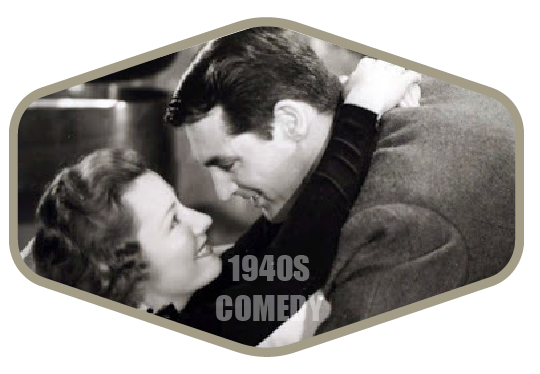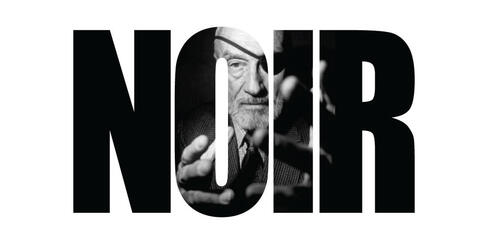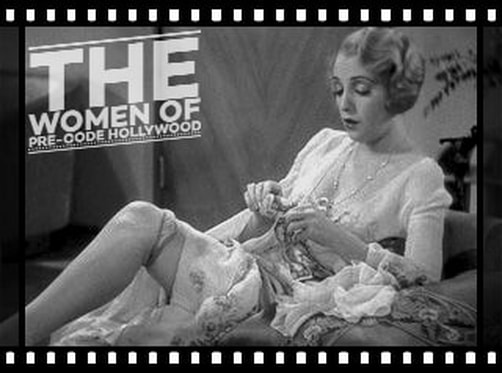Against the backdrop of WWII, Studios were engaged in promoting war bonds, military training films and morale-boosters. WWII also provided inspiration for military-themed comedies - finding endless humor in service, civil defense, boot-camp and shore-leave.
The war also removed some famous names from movie marquees. Enlisting in the armed services were: James Stewart, Kirk Douglas, Jason Robards, Clark Gable, Audrey Hepburn, Paul Newman, Henry Fonda, and Douglas Fairbanks Jr., among others.
Comedy films in the 1940s were a mixed bag of playful screwball comedies: The Philadelphia Story (1940), My Favorite Blonde (1942), Heaven Can Wait (1943) and slapstick comedies from aging stars of the '30s: W.C.Fields in The Bank Dick (1940) and the Marx Brothers in The Big Store (1941) and Laurel & Hardy in Nothing But Trouble (1944).
It was also the era of comedy duos: Bob Hope & Bing Crosby Staring with Dorothy Lamour in 5 "Road Films" in the '40s) , Bud Abbott & Lou Costello (Abbott & Costello Meet Frankenstein (1948) to open a series of salutes to Universal Monsters).
Katharine Hepburn & Cary Grant, ( The Philadelphia Story (1940) - 1 of 4 films they made together) Katharine Hepburn & Spencer Tracy (Woman of the Year (1942) 1 of 9 films made together), William Powell & Myrna Loy (Love Crazy (1941) - 1 of 14 films -including the 5 "Thin Man" series).
The war also removed some famous names from movie marquees. Enlisting in the armed services were: James Stewart, Kirk Douglas, Jason Robards, Clark Gable, Audrey Hepburn, Paul Newman, Henry Fonda, and Douglas Fairbanks Jr., among others.
Comedy films in the 1940s were a mixed bag of playful screwball comedies: The Philadelphia Story (1940), My Favorite Blonde (1942), Heaven Can Wait (1943) and slapstick comedies from aging stars of the '30s: W.C.Fields in The Bank Dick (1940) and the Marx Brothers in The Big Store (1941) and Laurel & Hardy in Nothing But Trouble (1944).
It was also the era of comedy duos: Bob Hope & Bing Crosby Staring with Dorothy Lamour in 5 "Road Films" in the '40s) , Bud Abbott & Lou Costello (Abbott & Costello Meet Frankenstein (1948) to open a series of salutes to Universal Monsters).
Katharine Hepburn & Cary Grant, ( The Philadelphia Story (1940) - 1 of 4 films they made together) Katharine Hepburn & Spencer Tracy (Woman of the Year (1942) 1 of 9 films made together), William Powell & Myrna Loy (Love Crazy (1941) - 1 of 14 films -including the 5 "Thin Man" series).
COMEDY FILMS OF THE 1940s
 ABBOTT AND COSTELLO MEET FRANKENSTEIN (1948)
ABBOTT AND COSTELLO MEET FRANKENSTEIN (1948) (83 Min.) Genre: 1940 COMEDY, Transfer Quality: A
It seems that Count Dracula (Bela Lugosi), in league with a beautiful but diabolical lady scientist (Lenore Aubert), needs a "simple, pliable" brain with which to reactivate Frankenstein's creature (Glenn Strange). The "ideal" brain belongs to the hapless Lou Costello, whom the lady doctor woos to gain his confidence and lure him to the operating table. Lawrence Talbot (Lon Chaney Jr.), better known as the Wolf Man, arrives on the scene to warn Costello and his pal Bud Abbott of Dracula's nefarious schemes. Throughout the film, the timorous Costello witnesses the nocturnal rituals of Dracula and the Monster, but can't convince the ever-doubting Abbott—until the wild climax in Dracula's castle, where the comedians are pursued by all three of the film's monstrosities. As a bonus, the Invisible Man (voiced by an unbilled Vincent Price) shows up for "all the excitement." — Hal Erickson
Starring: Bud Abbott, Lou Costello, Lon Chaney, Jr., Bela Lugosi, Glenn Strange | Directed by: Charles Barton
 AIR RAID WARDENS (1943)
AIR RAID WARDENS (1943) (67 Min.) Genre: 1940 COMEDY, Transfer Quality: A
Stan Laurel and Oliver Hardy's return to MGM, who had released their best Hal Roach comedies in the 1930s, reunites the team with former Roach director Edward Sedgwick and longtime foil Edgar Kennedy. That the resulting comedy isn't better than it is must be blamed on the period in which it was made. That most patriotic of Hollywood studios, MGM was not about to poke fun at home front security and the comedy comes to a screeching halt as Stan and Ollie soberly explain the need for blackouts. Unbeknownst to the team, a blackout has been called off and they proceed to pester poor Edgar Kennedy in what ought to have been a riotous encounter. The result is disappointing mainly because of MGM's failure to properly pace the scene, a fault that also bedeviled the company's Bud Abbott and Lou Costello vehicles. Despite its many flaws, Air Raid Wardens is still preferable to Laurel and Hardy's previous Fox efforts: Great Guns (1941) and A-Haunting We Will Go (1942). — Hans J. Wollstein
Starring: Stan Laurel, Oliver Hardy, Henry O'Neill, Lee Phelps | Directed by: Edward Sedgwick
 ARSENIC AND OLD LACE (1944)
ARSENIC AND OLD LACE (1944) (118 Min.) Genre: 1940 COMEDY, Transfer Quality: A
Hilarious adaptation of Joseph Kesselring's hit play (scripted by the Epstein Bros.) about two seemingly harmless old ladies who poison lonely gentlemen callers. Frantic cast is excellent, especially Lorre and Massey as unsuspecting murderers holed up in Brooklyn household. Made in 1941.
Starring: Cary Grant, Priscilla Lane, Raymond Massey, Peter Lorre, Jack Carson | Directed by: Frank Capra
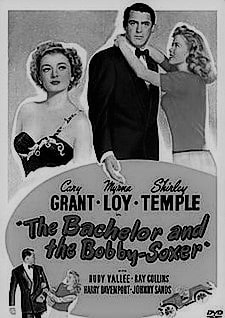 BACHELOR AND THE BOBBY-SOXER, THE (1947)
BACHELOR AND THE BOBBY-SOXER, THE (1947) (95 Min.) Genre: 1940 COMEDY, Transfer Quality: A
Judge Myrna Loy decides that the best way to curb the excesses of playboyish art teacher Cary Grant is to force him to do what he does best--romance a willing young lady. In this instance, the girl is Loy's own sister, played by a blossoming Shirley Temple. Aware that Temple has a serious crush on Grant, Loy orders him to date the teen-aged Temple until the girl gets him out of her system; he is also ordered to keep his hands to himself lest he wind up in the pokey. Grant finds the irrepressible Temple rather wearisome, but he throws himself into his sentence full-force, donning teenaged clothes, speaking in nonsense slang ("Voodoo! Who Do? You Do!" etc.) and participating in the athletic events at a high school picnic. Grant eventually divests himself of Temple by arranging for her to fall for a boy her own age; meanwhile, Loy realizes what we've realized all along--that it is she who is truly smitten by Grant. Adding to the frothy fun of Bachelor and the Bobby-Soxer are the supporting performances of Ray Collins as a sagacious psychologist and Rudy Vallee as a stuffy district attorney. The film's screenplay won an Academy Award for Sidney Sheldon, who went on to create I Dream of Jeannie and to matriculate into a best-selling novelist
Starring: Cary Grant, Myrna Loy, Shirley Temple, Rudy Vallee, Veda Ann Borg | Directed by: Irving G. Reis
 BALL OF FIRE (1941)
BALL OF FIRE (1941) (120 Min.) Genre: 1940 COMEDY, Transfer Quality: A
Ball of Fire is a delightful retelling (by Billy Wilder and Charles Brackett) of the "Snow White and the Seven Dwarfs" legend — though strictly for grownups. Gary Cooper is the youngest of eight bookish professors assembling a dictionary of slang. They find a perfect "research associate" in the curvaceous form of stripteaser Barbara Stanwyck, who (chastely) hides on the professors' domicile to escape her gangster boyfriend (Dana Andrews). As Stanwyck interprets various slang expression, she and the professors grow quite fond of one another; she brings out their sentimental sides, while they revive her essential decency. Naturally, Cooper is the one most smitten, though he hides his true feelings until the inevitable clinch. When gangster Andrews and his torpedo Dan Duryea show up to claim Stanwyck (Andrews wants to marry her so she can't testify against him), the professors save the day and it is Cooper who ends up with the beautiful Stanwyck. For the record, two of the "ancient" professors are Richard Haydn and O.Z. Whitehead, still in their mid-thirties (the others are S.Z. Sakall, Tully Marshall, Oscar Homolka, Leonid Kinskey and Aubrey Mather). Producer Sam Goldwyn later remade Ball of Fire as a Danny Kaye musical, A Song is Born (1948). — Hal Erickson
Starring: Gary Cooper, Barbara Stanwyck, Oscar Homolka, Dana Andrews, Elisha Cook Jr. | Directed by: Howard Hawks
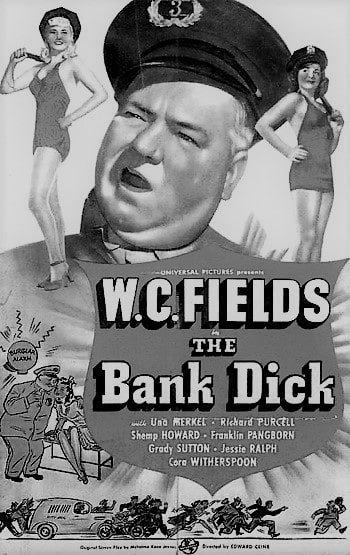 BANK DICK, THE (1940)
BANK DICK, THE (1940) (74 Min.) Genre: 1940 COMEDY, Transfer Quality: A
W.C. Fields plays Egbert Souse, a bibulous denizen of Lompoc who supports his family by winning radio contests. When a fleeing bank robber is knocked cold upon tripping over the park bench where Egbert sits, Souse is hailed as a hero and offered the job of bank guard. The next day, he is approached by one J. Frothingham Waterbury (Russell Hicks), who offers to sell Egbert shares in the Beefsteak Mines. Souse raises the necessary money by convincing bank clerk Og Oggilby (Grady Sutton), the fiance of Egbert's daughter Myrtle (Una Merkel), to "borrow" some funds from the bank; it isn't really embezzling, explains Egbert, because the mine is bound to pay off. Unfortunately, bank examiner J. Pinkerton Snoopington (Franklin Pangborn) comes calling, spelling possible trouble for Souse. — Hal Erickson
Starring: W.C. Fields, Cora Witherspoon, Una Merkel, Evelyn del Rio | Directed by: Eddie Cline
 BIG STORE, THE (1941)
BIG STORE, THE (1941) (84 Min.) Genre: 1940 COMEDY, Transfer Quality: A
The last of the Marx Bros.' MGM films, The Big Store is also the least — though a few good gags manage to seep through the overall tedium. Groucho Marx plays two-bit detective Wolf J. Flywheel, hired by department-store owner Martha Phelps (Margaret Dumont) to act as bodyguard for Martha's nephew and sole heir Tommy Rogers (Tony Martin). Crooked store manager Grover (Douglas Dumbrille) is anxious to take over the operation and to hide the fact that he's been juggling the books; to expedite this, he has arranged several "accidents" to put Tommy out of the way. Despite his monumental ineptitude, Flywheel manages to protect Tommy from harm, with the help of his mute assistant Wacky (Harpo Marx) and Tommy's music-teacher pal Ravelli (Chico Marx). After a series of yawn-provoking complications, Grover tries once more to kill Tommy during a musical reception given in honor of the store's merger with the Hastings Brothers. When this also fails, he kidnaps Tommy's girl friend Joan (Virginia Grey), a bit of skullduggery captured on film by camera-wielding Ravelli. Grover's efforts to get his hands on the incriminating photo leads to a zany slapstick chase through the department store, culminating in the villain's capture ("I told you in the first reel he was a crook", observes Flywheel) and a happy ending for Tommy and Joan. The opening routine in Groucho's seedy office and Harpo's harp solo (in which, through trick photography, he accompanies himself on flute and bass violin) are the only scenes truly worth watching in The Big Store; the big-chase finale is compromised by the fact that the Marx Bros.' stunt doubles do all the work, while the film's major production number, "Tenement Symphony", is downright embarrassing. The Marxes were so disappointed with The Big Store that they vowed to quit moviemaking altogether-only to return to the screen five years later in A Night in Casablanca. — Hal Erickson
Starring: The Marx Brothers, Margaret Dumont, Virginia Grey, Tony Martin | Directed by: Charles Reisner
 BLONDE FEVER (1944)
BLONDE FEVER (1944) (69 Min.) Genre: 1940 COMEDY, Transfer Quality: A
MGM's notion of a "B" picture would be an "A" production at any other studio, and Blonde Fever is no exception. Philip Dorn heads the cast as restauranteur Peter Donay, happily married to the pleasant but plain Delilah (Mary Astor). Approaching "that certain age", Donay's head is turned by curvaceous waitress Sally Murfin (Gloria Grahame, in her first important film role). At first only mildly amused by the flirtatious Donay, Sally begins turning on the charms herself when she finds out that he's won a $40000 lottery. It takes six reels, but Donay finally realizes how much he loves and needs his faithful wife, and how little Sally truly cares about him. Blonde Fever is based on a play by Ferenc Molnar, though it must have taken a lot of cutting to cram the original into 65 minutes' running time. PS: Hume Cronyn and Jessica Tandy, personal friends of director Richard Whorf, show up in unbilled cameos.
Starring: Philip Dorn, Mary Astor, Gloria Grahame, Felix Bressart, Marshall Thompson, Jessica Tandy, Hume Cronyn | Directed by: Richard Whorf
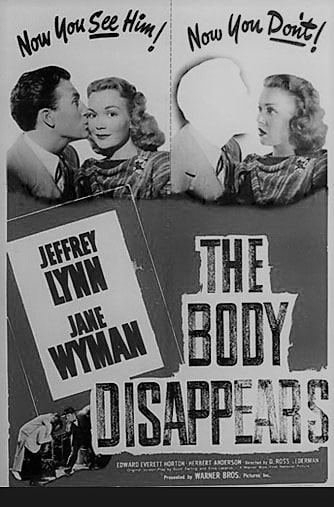 BODY DISAPPEARS, THE (1941)
BODY DISAPPEARS, THE (1941) (72 Min.) Genre: 1940 COMEDY, Transfer Quality: A
Possibly inspired by Universal's The Invisible Woman, Warner Bros.' The Body Disappears is an agreeably daffy comedy with science-fiction undertones. Passing out from overindulgence during his engagement party, young millionaire Peter De Haven is placed on a slab in a college dissecting room by his prankish friends. Before Peter can awaken, he is inadvertently kidnapped by eccentric Professor Shotsbury (Edward Everett Horton), who needs a "dead body" upon which to test his new life-restoring serum. Shotsbury's miracle drug succeeds only in making Peter invisible, leading to all manner of looney complications. Before the film's 72 minutes are over, Peter has discovered that his "loving" fiancee Christine Lunceford (Margerite Chapman) is merely a gold-digger, Prof. Shotsbury has been locked up in the nuthouse, and Shotsbury's perky daughter Joan (Jane Wyman) has become invisible himself, implictly cavorting about naked with no one any the wiser. Still fresh and funny after nearly six decades, The Body Disappears is sometimes shown on TV minus the "scared-rabbit" comedy routines of black actor Willie Best. — Hal Erickson
Starring: Jeffrey Lynn, Jane Wyman, Edward Everett Horton, Sidney Bracey | Directed by: David Ross Lederman
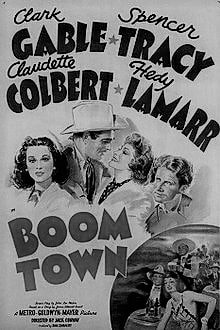 BOOM TOWN (1940)
BOOM TOWN (1940) (119 Min.) Genre: 1940 COMEDY, Transfer Quality: A
Clark Gable is "Big John" and Spencer Tracy is "Square John"; both "Johns" seek their fortunes in the Texas oil fields. They simultaneously fall in love with Claudette Colbert, but it's "Big John" who wins out. When both Johns grow rich on oil, "Big John" lets money go to his head, and he begins neglecting wife Colbert for Hedy Lamarr, the "been around" companion of businessman Lionel Atwill. "Square John", who still carries a torch for Colbert but doesn't want to see her heart broken, tries to buy off Lamarr; when this fails, he decides to ruin "Big John" financially. But when "Big John" is charged with violating anti-trust rules by the crooked Atwill, "Square John" rushes to the side of his old pal. Both men end up where they started—broke but happy. "Big John" returns to faithful Colbert, while "Square John" stands by with an ear-to-ear grin. Boom Town was the last film to co-star Clark Gable and Spencer Tracy; though Tracy was fond of Gable, he resented playing "eunuch" in their on-screen romantic triangles. Claudette Colbert's scenes with Clark Gable are pleasant enough, but the sparks that had ignited their scenes in It Happened One Night are largely absent here. — Hal Erickson
Starring: Clark Gable, Spencer Tracy, Claudette Colbert, Hedy Lamarr | Directed by: Jack Conway
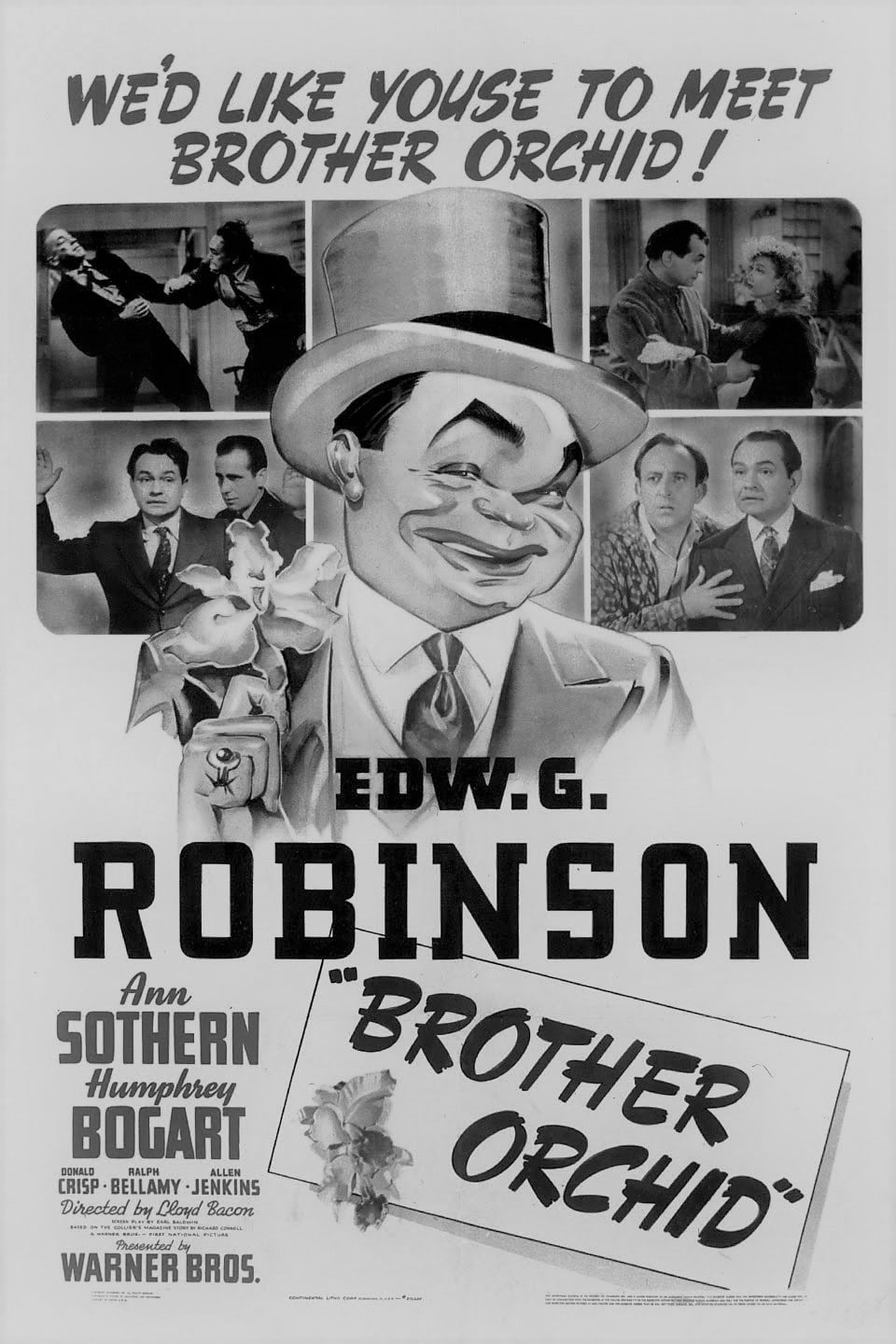 BROTHER ORCHID (1940)
BROTHER ORCHID (1940) (87 Min.) Genre: 1940 COMEDY, Transfer Quality: B
Edward G. Robinson plays orchid-loving gangster Little John Sarto, who aspires to "real class." During a power struggle with usurping mobster Jack Buck (Humphrey Bogart), Sarto is taken for a one-way ride, but he escapes his would-be assassins and hides out in a monastery overseen by Brother Superior (Donald Crisp). Sarto insists that he'd like to become a monk himself, but in fact he's using the monastery as a hideout, the better to mount his counterattack against Buck. Eventually Sarto's resolve is weakened by the kindness of the monks, and he decides to turn over a new leaf. He sees to it that Buck is brought to justice, and also fixes up his true-blue "moll," Flo Addams (Ann Sothern), with good-hearted Texas rancher Clarence Fletcher (Ralph Bellamy). (News flash! Bellamy gets the girl for once!) Sarto, now known as "Brother Orchid," returns to the monastery for good, declaring that he's finally found the real class. Though Edward G. Robinson didn't want to play another gangster, he agreed to star in Brother Orchid in exchange for being allowed to essay the lead in Warner Bros.' historical drama A Dispatch From Reuter's (1940).
Starring: Edward G. Robinson, Humphrey Bogart, Donald Crisp, Ralph Bellamy | Directed by: Lloyd Bacon
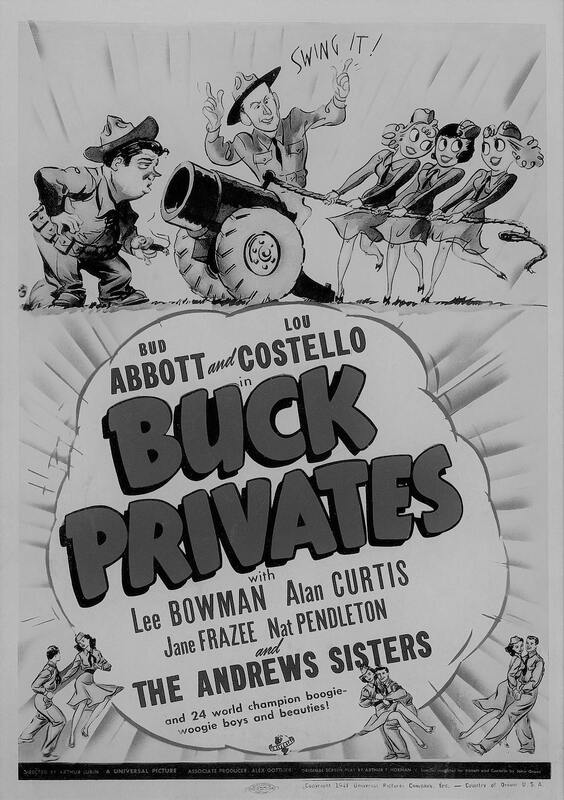 BUCK PRIVATES (1941)
BUCK PRIVATES (1941) (84 Min.) Genre: 1940 COMEDY, Transfer Quality: A
Filmed on a B-picture budget, Buck Privates was Universal's biggest box-office hit of 1941, firmly securing the movie popularity of the studio's hot new team of Bud Abbott and Lou Costello. The story is fairly evenly divided between the antics of Bud and Lou-here cast as sidewalk salesmen Slicker Smith and Herbie Brown-and the romantic triangle involving Randolph Parker III (Lee Bowman), Judy Gray (Jane Frazee) and Bob Martin (Alan Curtis). Escaping the wrath of policeman Mike Collins (Nat Pendleton), Slicker and Herbie duck into a nearby movie theater, which unbeknownst to them has been converted into a US Army recruiting center. As the boys are reluctantly inducted into the Service, wealthy draftee Parker hopes to pull a few strings to avoid putting on a uniform, while Parker's former chauffeur Martin willingly answers his call to the Colors. Once ensconced in boot camp, Slicker and Herbie continually run afoul of their sergeant, who is none other than their old nemesis Mike the cop. Meanwhile, Parker and Martin vie for the attentions of USO hostess Judy, who'll have nothing to do with Parker until he proves his worth as a soldier. Poor Slicker and Herbie are shunted into the background as the romantic subplot is resolved, but at least our heroes get to steal the film's closing scene. It's hard to believe that anyone cared about the Parker-Martin-Judy triangle with Abbott & Costello on hand to perform their classic "dice game", "awkward squad", "turn on the radio" and "boxing ring" routines-not to mention their timeless verbal exchanges, the best of which finds Bud convincing Lou that if he marries an underage girl, she'll eventually be older than he (it plays better than it reads!) As a bonus, the film spotlights the Andrews Sisters, performing such top-ten tunes as "Apple Blossom Time" and "Boogie Woogie Bugle Boy". Even from the vantage point of six decades, with the WWII draft but a dim memory, it is easy to see why Buck Privates was such a huge success. — Hal Erickson
Starring: Bud Abbott, Lou Costello, Lee Bowman, Jane Frazee, The Andrews Sisters | Directed by: Arthur Lubin
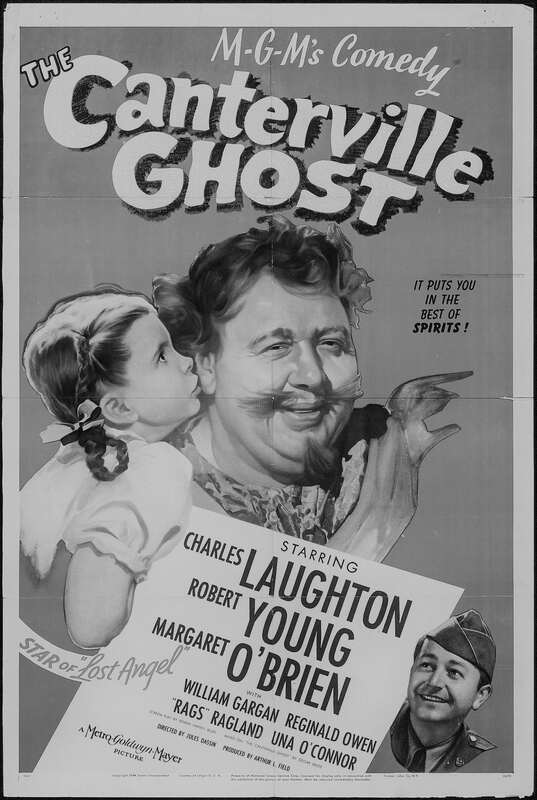 CANTERVILLE GHOST, THE (1944)
CANTERVILLE GHOST, THE (1944) (96 Min.) Genre: 1940 COMEDY, Transfer Quality: A
The whimsical Oscar Wilde fantasy yarn The Canterville Ghost is updated to WW2 in this economical but attractively produced MGM filmization. Charles Laughton plays Sir Simon de Canterville, a feckless 17th century British aristocrat who, after proving himself a coward on the field of honor, is walled up alive in his own castle by his unforgiving father (Reginald Owen). Sir Simon's ghost is doomed to haunt the corridors of Canterville Hall until one of his descendants performs a conspicuous act of bravery. 300 years later, the castle is billetted by a platoon of American soldiers-one of whom, Cuffy Williams (Robert Young), is of course a distant relation to Sir Simon. The ghost of Canterville Hall does his best to frighten away the American "intruders", but he's a fairly incompetent spirit, incapable of frightening even the young mistress of the castle, 8-year-old Lady Jessica (Margaret O'Brien). Upon learning of his family legacy, Cuffy begins worrying that he, too, will prove to be a coward when the chips are down, but with the help of the Ghost and the stalwart Lady Jessica, Cuffy is able to summon up his innate courage. Sharp-eyed viewers will spot Peter Lawford in a tiny role as Sir Simon's ill-fated brother, and cult figure Tor Johnson as Simon's fearsome jousting opponent. Though never remade theatrically, The Canterville Ghost resurfaced in TV-movie form 1986 and 1996. — Hal Erickson
Starring: Charles Laughton, Robert Young, Margaret O'Brien, Peter Lawford | Directed by: Jules Dassin
 CHUMP AT OXFORD, A (1940)
CHUMP AT OXFORD, A (1940) (63 Min.) Genre: 1940 COMEDY, Transfer Quality: A
Back at Hal Roach Studios for the first time since 1938's Block-Heads, Stan Laurel and Oliver Hardy star in the uneven but generally rewarding A Chump at Oxford. The boys are cast as street-sweepers who hope to better their lot in life by attending night school. Fate intervenes when Stan and Ollie are instrumental in the capture of a bank robber, whereupon they are rewarded by the bank's grateful president (Forbes Murray) with an all-expenses-paid education at England's Oxford University. Arriving on the venerable old campus dressed in Eton jackets, our heroes are pounced upon by a group of prankish students and subjected to all manner of practical jokes. After spending most of the night trying to escape from a maze, Stan and Ollie are installed in their "new quarters"-which turns out to be the bedroom of the Dean (Wilfred Lucas). This sort of collegiate nonsense comes to an end when it is discovered that simple-minded Stan is actually Lord Paddington, the brainiest student and finest athlete that ever attended Oxford. According to Meredith the valet (Forrester Harvey), His Lordship wandered away from the university upon being rendered an amnesiac by a blow on the head. An accidental tap on the noggin restores Stan to his aristocratic Lord Paddington status, whereupon he beats up a crowd of bullying students and deposits them one by one in a nearby ditch. Though Ollie is aghast to learn that Stan-er, His Lordship-has no recollection of their previous friendship, he decides to stay on at Oxford as Paddington's manservant. After having been humiliated once too often by his vain and condescending employer, Ollie angrily packs his bags and prepares to head for home, when yet another bop on His Lordship's skull causes him to revert to lovable, bumbling old Stan again. Originally intended as a four-reeler (running approximately 45 minutes), A Chump at Oxford was completed in the spring of 1939, whereupon Laurel and Hardy were loaned out to producer Boris Morros to star in The Flying Deuces. When shooting was finished on the latter film, the team was summoned back to Roach to film a 2-reel "prologue" for Oxford, bringing the film's running time up to 63 minutes. The new footage consisted of a reworking of the boys' 1928 comedy From Soup to Nuts, with temporary servants Stan and Ollie unintentionally wrecking a dinner party held by Mr. and Mrs. Vandevere (played by veteran L&H supporting players James Finlayson and Anita Garvin). The patchwork stucture of A Chump at Oxford works against its overall effectiveness, but the scenes in which Stan Laurel undergoes a complete change of character as the genius-level Lord Paddington more than make up for the film's earlier shortcomings. One of the students (the tall, mustachioed one) is played by Peter Cushing, in his second Hollywood film appearance. — Hal Erickson
Starring: Stan Laurel, Oliver Hardy, James Finlayson, Wilfred Lucas | Directed by: Alfred Goulding
 COMRADE X (1940)
COMRADE X (1940) (90 Min.) Genre: 1940 COMEDY, Transfer Quality: A
A half-hearted derivation of Ninotchka, Comrade X stars Clark Gable as an American news reporter stationed in Russia. Gable is actually the mysterious Comrade X, who has been smuggling provocative stories about the crumbling Soviet government out of the country. Threatened with exposure by a hotel porter (Felix Bressart), Gable agrees to help sneak the porter's beautiful daughter (Hedy Lamarr) out of Russia. The girl is a devout "old line" Communist, and thus is regarded as a potential counter-revolutionary by the paranoid Soviet leaders. Gable pretends to be a Communist himself to win Hedy's trust, inviting her to America to espouse her cause. He finds he can only secure her passport by marrying her, which leads to the anticipated complications. The Soviet higher-ups imprison Gable and Lamarr, sentencing them to death—but suddenly the counter-revolutionaries take charge of the government prison and arrest the arresters! The new man in charge (Sig Rumann) is Lamarr's political idol, but when he reveals himself to be vulnerable to blackmail and bribes, Lamarr becomes disillusioned by the Party Line and accompanies her new husband Gable to America. Filmed just before the "shifty" Communists were metamorphosed into brave freedom fighters by World War II-vintage filmmakers, Comrade X is of marginal historical value. Otherwise, it is an unfunny low point in the careers of Clark Gable and Hedy Lamarr. — Hal Erickson
Starring: Clark Gable, Hedy Lamarr, Oscar Homolka, Felix Bressart | Directed by:
 CORPSE CAME C.O.D., THE (1947)
CORPSE CAME C.O.D., THE (1947) (87 Min.) Genre: 1940 COMEDY, Transfer Quality: A
Reminiscent of the classic "screwball" comedy-mysteries of the prewar years, Columbia's The Corpse Came C.O.D stars Warner Bros. alumni George Brent and Joan Blondell as rival Hollywood-based reporters Joe Medford and Rosemary Durant. When movie star Mona Harrison (Adele Jergens) receives a dead body in her morning mail, Joe and Rosemary fall over each other trying to solve the mystery and deliver a newspaper story "that'll tear this town wide open." Joe deduces that the dead man was involved with a jewelry-smuggling racket, while Rosemary chases down the stolen gems. Three murders later, the two reporters expose the killer-and though it wouldn't be nice to reveal the killer's identity, it's also worth noting that it won't be much of a surprise, either. Topheavy with comedy at the expense of mystery, The Corpse Came C.O.D. is an entertaining trifle, with the actual Columbia backlot standing in for the movie's fictional film studio.
Starring: George Brent, Joan Blondell, Adele Jergens, Leslie Brooks | Directed by: Henry Levin
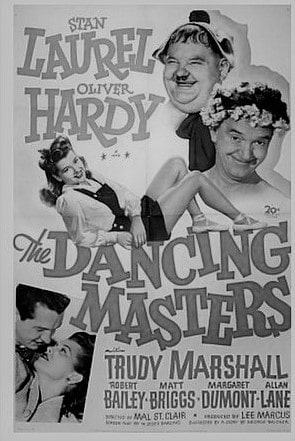 DANCING MASTERS, THE (1943)
DANCING MASTERS, THE (1943) (63 Min.) Genre: 1940 COMEDY, Transfer Quality: A
This lesser Laurel and Hardy vehicle casts Stan and Ollie as the proprietors of the "Arthur Hurry" dance studio. Despite a rather sizeable student body (consisting mainly of 20th Century-Fox contract starlets), the boys would starve to death were it not for their only paying customer, socialite Trudy Harlan (Trudy Marshall). Trudy is in love with Grant Lawrence (Robert Bailey), an aspiring inventor who needs financial backing for his revolutionary new flame thrower. Laurel and Hardy undertake several moneymaking schemes to help Grant, most of these coming a-cropper. Finally, Ollie remembers an accident-insurance policy taken out on Stan. He tries to arrange an accident so that the boys can collect a huge fee, but this scheme culminates in a wild bus ride, resulting in Ollie breaking his own leg. The plot of Dancing Masters is a hodgepodge of underdeveloped situations and old gags lifted from such earlier Laurel & Hardy comedies as The Battle of the Century and Thicker Than Water; only occasionally does the comic genius of Stan and Ollie shine through. If the film is memorable at all, it is because of the presence of Robert Mitchum, in an unbilled but sizeable role as an insurance racketeer.
Starring: Stan Laurel, Oliver Hardy, Margaret Dumont, Robert Mitchum | Directed by: Malcolm St. Clair
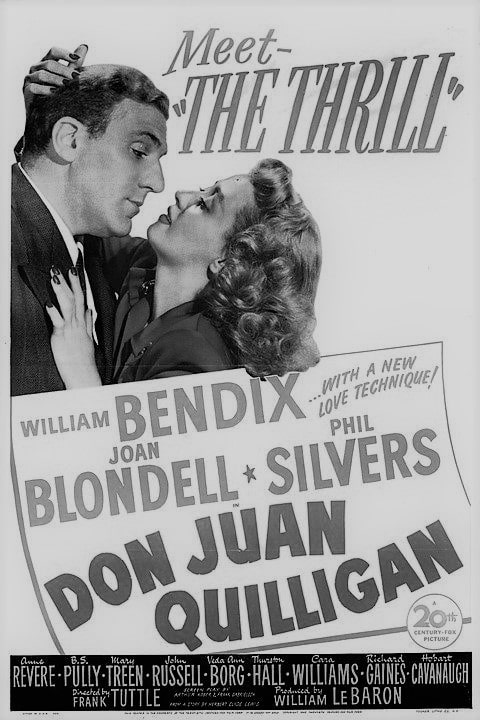 DON JUAN QUILLIGAN (1945)
DON JUAN QUILLIGAN (1945) (75 Min.) Genre: 1940 COMEDY, Transfer Quality: A
In this comedy, a barge captain with an Electra complex marries two women. He married the first because she laughed like his late mother. He married the other because she cooks like his mom. He soon finds himself in over his head. A good friend helps extricate him by devising an ingenious plot. The captain is to be blamed for a murder. He can then escape his wives by pretending to be sent to prison. — Sandra Brennan
Starring: William Bendix, Joan Blondell, Phil Silvers, Anne Revere | Directed by: Frank Tuttle
 DOUGHGIRLS, THE (1944)
DOUGHGIRLS, THE (1944) (102 Min.) Genre: 1940 COMEDY, Transfer Quality: A
The wartime housing shortage in Washington DC is the basis for this comedy. Several attractive young ladies rent a single DC apartment, causing no end of complications to their various professional and private lives. Also moving in (due to a misunderstanding) is a young newlywed (Jane Wyman), whose flustered husband (Jack Carson) is denied access to the apartment. The funniest of the female roommates is a visiting Russian sniper, played con brio by Eve Arden. The Doughgirls is based on the popular Broadway play by Joseph A. Fields (with uncredited assistance by George S. Kaufman). Three Stooges fans are advised to keep an eye out for Curly Joe DeRita as an unhappy schlemiel who can't find a place to sleep.
Starring: Ann Sheridan, Alexis Smith, Jack Carson, Jane Wyman, Charlie Ruggles, Eve Arden, Eve Arden | Directed by: James Kern
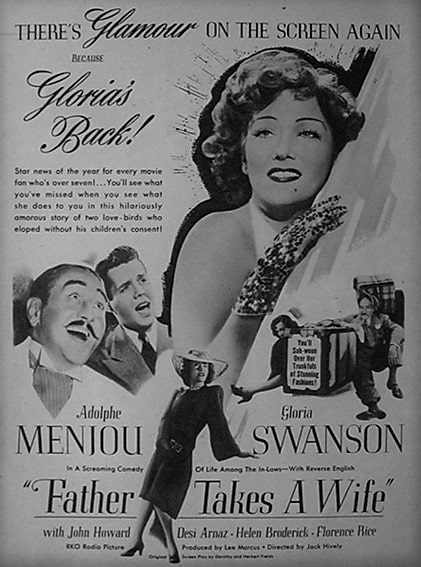 FATHER TAKES A WIFE (1941)
FATHER TAKES A WIFE (1941) (79 Min.) Genre: 1940 COMEDY, Transfer Quality: A
Silent screen queen Gloria Swanson returned to films after a seven-year absence in RKO Radio's Father Takes a Wife. Adolphe Menjou costars as a middle-aged widowed shipping magnate known as Senior, who falls in love with celebrated actress Leslie Collier (Gloria Swanson) and marries her after a whirlwind courtship. Now Senior must break the news to his strait-laced son Junior (John Howard), who disapproves of show people. Junior is convinced that Leslie will leave his father the moment a younger, handsomer man enters the scene-a prediction that seems to come true when the honeymooning couple make the acquaintance of South American singing hearthrob Carlos (Desi Arnaz). Meanwhile, Leslie's jealousy is aroused when she sees Senior in the company of gorgeous young Enid (Florence Rice), unaware that the girl is Senior's daughter-in-law. All misunderstandings are forgotten when it turns out that both Leslie and Enid are about to become mothers-legitimately! Though Gloria Swanson was in fine fettle, Father Takes a Wife failed to draw a crowd, posting a loss of $104,000; eight years later, Swanson staged a real comeback in the classic Sunset Boulevard.
Starring: Adolphe Menjou, Gloria Swanson, John Howard, Desi Arnaz, Helen Broderick | Directed by: Jack Hively
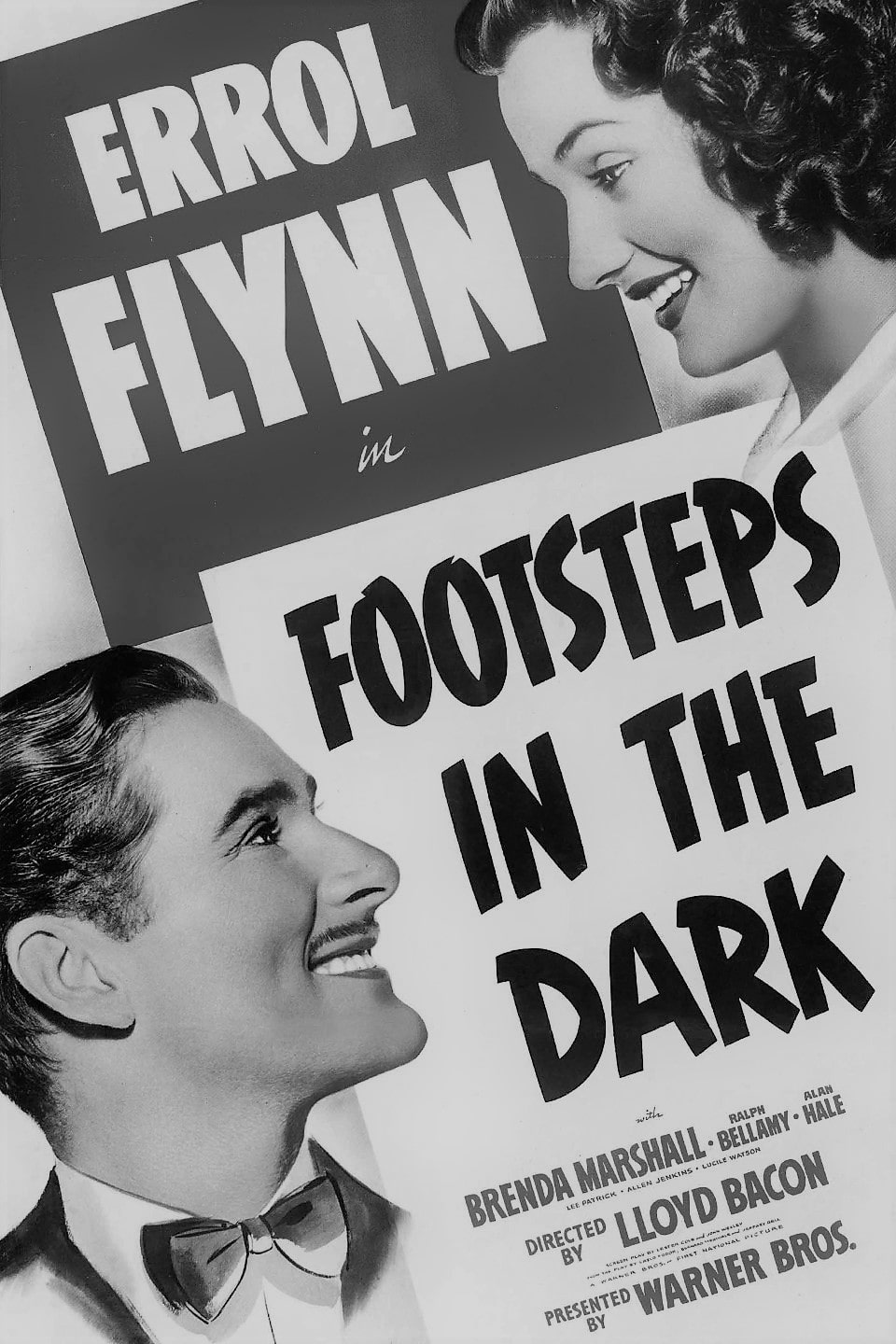 FOOTSTEPS IN THE DARK (1941)
FOOTSTEPS IN THE DARK (1941) (96 Min.) Genre: 1940 COMEDY, Transfer Quality: A
Footsteps in the Dark is a comedy/mystery, starring Errol Flynn as a wealthy investment counselor who secretly doubles as a dilettante detective, the better to write mystery novels. Brenda Marshall plays his wife, who can't understand why he is never home and begins to suspect hanky-panky. In fact, Flynn is investigating the murders of a jewelry smuggler and an exotic dancer. The trail of evidence leads to the Least Likely Suspect—portrayed, as is often the case, by an actor who's always the one who "did it" in murder mysteries. Not nearly as funny a film as the producers seem to think it is, Footsteps in the Dark is an obvious attempt by Warner Bros. to create a "Nick and Nora Charles" team, in emulation of MGM's popular Thin Man series. Footsteps ends with wife Marshall vowing to join hubby Flynn in his next murder mystery, leaving the door wide open for a sequel...which was never filmed. — Hal Erickson
Starring: Errol Flynn, Brenda Marshall, Ralph Bellamy, Alan Hale | Directed by: Lloyd Bacon
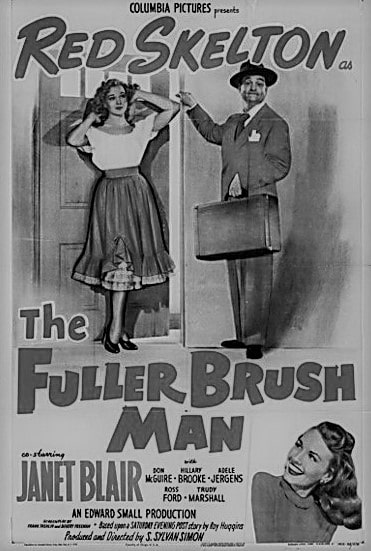 FULLER BRUSH MAN, THE (1946)
FULLER BRUSH MAN, THE (1946) (93 Min.) Genre: 1940 COMEDY, Transfer Quality: A
MGM knew it had a valuable property in Red Skelton, but the studio never really knew how to handle his unique talents -- until he was loaned out to Columbia for the hilarious, money-spinning slapstick comedy The Fuller Brush Man. The star plays Red Jones, a born screw-up who can't seem to hold down a job. With the help of his ever-loving girlfriend Ann Elliot (Janet Blair), Red gets a job as a Fuller Brush salesman, intending to take the business world by storm with his can't-fail sales techniques. Unfortunately, when Red isn't messing up on his own, he's being sabotaged by his supervisor Keenan Wallick (Don McGuire) -- who also happens to be sweet on Ann. While trying to make a sale at the home of Commissioner Trist (Nicholas Joy), poor Red finds himself the Number One Suspect when Trist is murdered. With Ann's help, Red eventually stumbles onto the identity of the actual killer, and the chase is on. And what a chase! Pursued by a battalion of thugs (played by several of Hollywood's top stunt men), Red and Ann hotfoot it through a well-stocked war surplus warehouse, wherein all the props -- rubber rafts, prefabricated houses, camouflage tents, flare guns -- are utilized to their utmost comic potential. A riot from beginning to end, The Fuller Brush Man may well be Skelton's funniest film. It was successful enough in 1948 to spawn a series of imitations -- The Good Humor Man, The Fuller Brush Girl, The Yellow Cab Man, Kill the Umpire - -all of which, like Fuller Brush Man, were co-scripted by the inexhaustibly inventive Frank Tashlin.
Starring: Red Skelton, Janet Blair, Don McGuire, Hillary Brooke, Adele Jergens | Directed by: S. Sylvan Simon / Frank Tashlin
 GHOST BREAKERS, THE (1940)
GHOST BREAKERS, THE (1940) (83 Min.) Genre: 1940 COMEDY, Transfer Quality: A
Paramount followed up its successful Bob Hope/Paulette Goddard co-starrer The Cat and the Canary (1939) by warming up another venerable "old dark house" stage play, Paul Dickey and Charles Goddard's The Ghost Breaker, pluralizing the title to accommodate both stars. This time Hope plays radio personality Lawrence L. Lawrence (the middle initial stands for Lawrence: "My folks had no imagination") who has to flee New York to avoid being mistakenly arrested for murder. He and his manservant Alex (Willie Best) book passage on a Cuba-bound liner, where they meet lovely heiress Mary Carter (Paulette Goddard). She is heading to Cuba to take charge of her ancestral mansion, despite warnings from several sinister characters that to enter this "haunted" house will mean certain death. Appointing himself Mary's protector, Lawrence investigates the mansion on his own, thereby crossing the path of a zombie (Noble Johnson) and an apparently genuine ghost. He also meets the twin brother of the man he's accused of killing (Anthony Quinn), who seems the most likely suspect when Mary nearly comes to harm. — Hal Erickson
Starring: Bob Hope, Paulette Goddard, Richard Carlson, Paul Lukas | Directed by: George Marshall
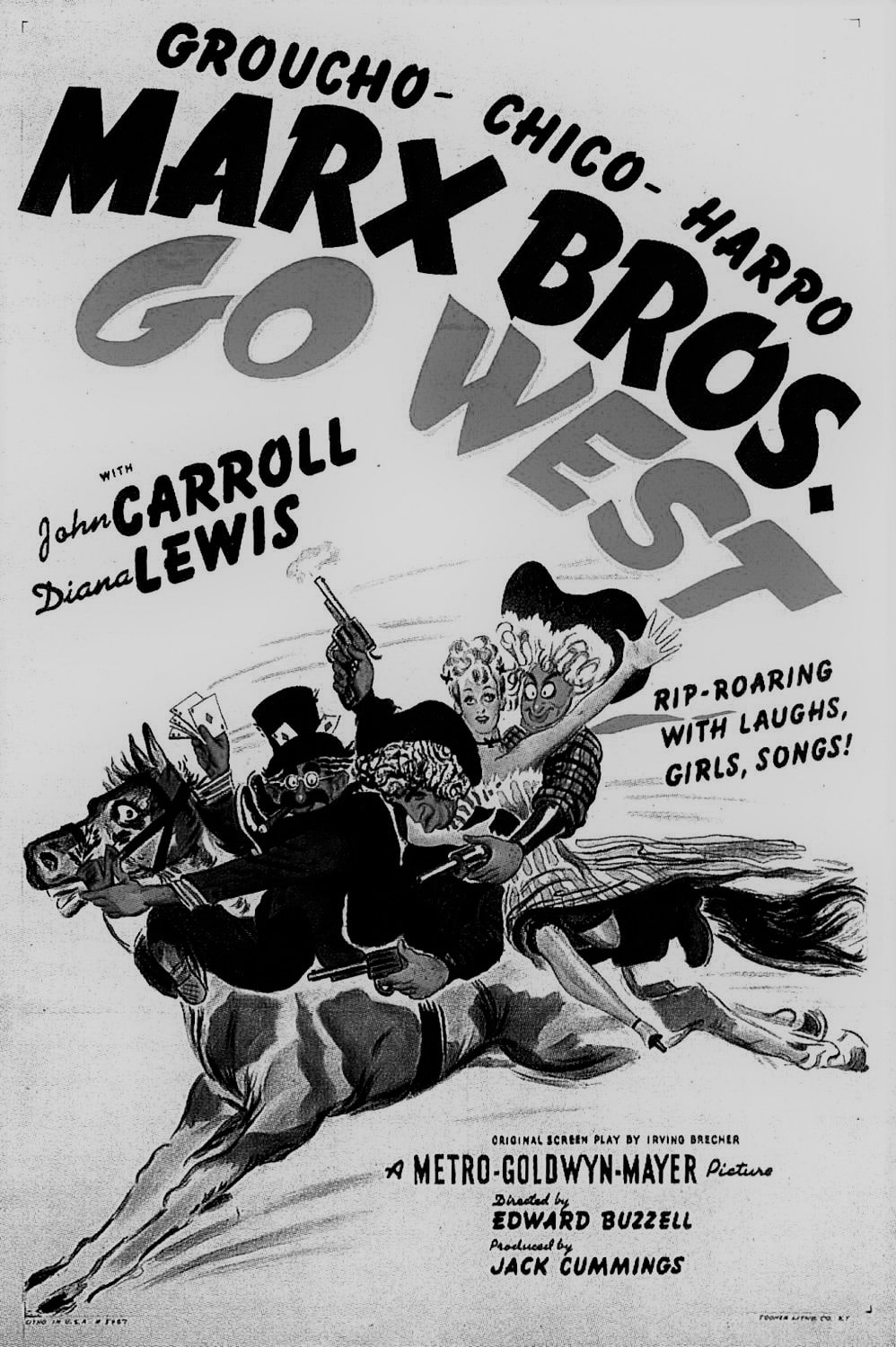 GO WEST (1940)
GO WEST (1940) (80 Min.) Genre: 1940 COMEDY, Transfer Quality: A
The Marx Bros.' Go West was on the drawing boards as early as 1936, when MGM executive Irving Thalberg commissioned Bert Kalmar and Harry Ruby to come up with a script in which the Marx Boys get involved with a rodeo. The project was shelved in favor of A Day at the Races, then revived in late 1939, two years after Laurel & Hardy's Way Out West proved the commercial viability of comedy westerns. By this time, Kalmar and Ruby were no longer involved, and the script became virtually the sole responsiblity of Irving Brecher, who'd previously penned the disappointing Marx vehicle At the Circus. If Go West is an improvement over Circus, it is probably because the Marxes were permitted to try out their material on tour before a variety of live audiences. Set in 1870, the story begins as S. Quentin Quayle (Groucho Marx) tries to raise enough money for a train ticket to the West. He spots a couple of likely pigeons, prospectors Rusty (Harpo Marx) and Joe (Chico Marx), and attempts to sucker them out of the required $500. In what turns out to be the film's funniest scene, Rusty and Joe turn the tables on Quayle, divesting him of everything he owns — including his trousers. The plot then rears its ugly head as villains Beecher (Walter Woolf King) and Baxter (Robert H. Barrat) scheme to wrest a lucrative railroad contract from hero Terry Turner (John Carroll). Rusty and Joe makes things easy for the bad guys by stupidly signing over a valuable gold-mine deed which they were supposed to deliver to heroine Eve Wilson (Diana Lewis). With the help of Quayle, Rusty and Joe try to recover the deed, only to be sidetracked by a bevy of dance-hall girls. After several middling complications, the film boils down to a race between heroes and villains to register their bids and win the railroad contract. This requires Quayle, Rusty and Joe to keep a locomotive in commission by chopping up the passenger cars for fuel, one of several Keatonesque sight gags packed into the film's hilarious finale. The opening and closing scenes of Go West are so good that one is willing to forgive and forget the dull romantic subplot and the misfire gags in the midsection. — Hal Erickson
Starring: The Marx Brothers, John Carroll, Diana Lewis, Walter Woolf King | Directed by: Edward N. Buzzell
 GOLDEN FLEECING, THE (1940)
GOLDEN FLEECING, THE (1940) (68 Min.) Genre: 1940 COMEDY, Transfer Quality: A
Dumb but honest insurance agent Henry Twinkle (Lew Ayres) is in love with Mary Blake (Rita Johnson), the secretary of Henry's boss. To impress Mary, Henry sells a huge policy to wealthy Gus Fender (Lloyd Nolan), who turns out to be a notorious gangster on the lam from the law. If he wants to save his job, Henry will have to protect Fender from being killed. After a series of hair-raising adventures, hapless Henry ends up collecting the reward money for Fender's capture, only to be duped into turning it all over to the gangster for bail money. Saving Henry's hide-and his relationship with Mary-is a share of seemingly worthless stock which unexpectedly pays off big-time.
Starring: Lew Ayres, Rita Johnson, Lloyd Nolan, Virginia Grey, Nat Pendleton, Marc Lawrence | Directed by: Leslie Fenton
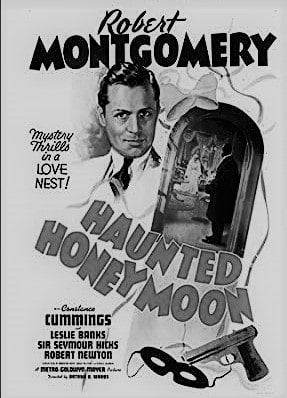 HAUNTED HONEYMOON (1940)
HAUNTED HONEYMOON (1940) (99 Min.) Genre: 1940 COMEDY, Transfer Quality: A
Released in America as Haunted Honeymoon, this droll British comedy-mystery stars Hollywood's Robert Montgomery as Dorothy L. Sayers' erudite amateur sleuth Lord Peter Wimsey. Upon marrying mystery writer Harriet Vane (Constance Cummings), Lord Peter swears off crime-solving and embarks upon his honeymoon. Alas, the couple is soon involved in yet another murder, and is forced by circumstances to piece together the clues themselves-and to avoid being knocked off by the murderer. Filmed at MGM's Elstree facilities, Busman's Honeymoon benefits from a strong "home-grown" supporting cast, including Leslie Banks and Robert Newton. The film was directed by the talented Arthur B. Woods, unfortunately an early casualty of WW2.
Starring: Robert Montgomery, Constance Cummings, Leslie Banks, Robert Newton, Seymour Hicks | Directed by: Arthur B. Woods
 HEAVEN CAN WAIT (1943)
HEAVEN CAN WAIT (1943) (112 Min.) Genre: 1940 COMEDY, Transfer Quality: A
Heaven Can Wait was Ernst Lubitsch's last great movie. The enduring classic came at the end of two decades of excellent work, which included such Hollywood masterpieces as Trouble in Paradise, Ninotchka, The Shop Around the Corner and To Be or Not to Be. In this era, the "Lubitsch Touch" became a marketable moniker which characterized his impact on the early sound days of Hollywood. Heaven is typical of the "Touch": it's a perfect blend of sophistication, romance, wit and bittersweet sentiment. The benevolent story reveals Don Ameche's life to be as average as any man's, but Lubitsch's genuine tenderness elevates the tale to the majestic. Ameche and Gene Tierney deliver mature, convincing performances, appropriate to the subject matter. Unfortunately, the film has a low-quality look, common to early Technicolor productions; it would be Lubitsch's first and last film shot entirely in color. Heaven was nominated for Oscars for Best Picture, Director, and Cinematography, and was a significant influence on director Frank Capra's beloved It's a Wonderful Life. — Brendon Hanley
Starring: Don Ameche, Gene Tierney, Charles Coburn, Marjorie Main | Directed by: Ernst Lubitsch
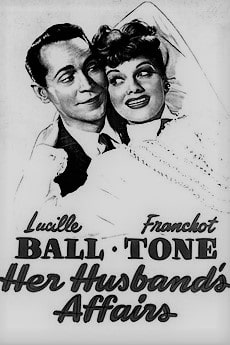 HER HUSBAND'S AFFAIRS (1947)
HER HUSBAND'S AFFAIRS (1947) (83 Min.) Genre: 1940 COMEDY, Transfer Quality: B
Lucille Ball offers a seminal version of her Lucy Ricardo TV character in Her Husband's Affairs. Ball is cast as Margaret Weldon, the wife of advertising executive William Weldon (Franchot Tone). Though Weldon is successful, Margaret can't help but feel that he'd be more successful if she were to take an active part in his business affairs. The fun really begins when Margaret tries to help Weldon promote a crackpot inventor (Mikhail Rasumny) who's come up with a revolutionary new embalming fluid. As in the previous year's The Hucksters, Madison Avenue and Big Business are targetted for a great deal of derisive ribbing. If only Her Husband's Affairs were as funny as everyone involved seems to think it is.
Starring: Lucille Ball, Franchot Tone, Nana Bryant, Edward Everett Horton | Directed by: S. Sylvan Simon
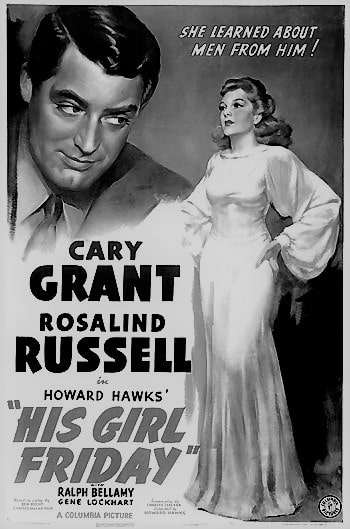 HIS GIRL FRIDAY (1940)
HIS GIRL FRIDAY (1940) (92 Min.) Genre: 1940 COMEDY, Transfer Quality: A
The second screen version of the Ben Hecht/Charles MacArthur play The Front Page, His Girl Friday changed hard-driving newspaper reporter Hildy Johnson from a man to a woman, transforming the story into a scintillating battle of the sexes. Rosalind Russell plays Hildy, about to foresake journalism for marriage to cloddish Bruce Baldwin (Ralph Bellamy). Cary Grant plays Walter Burns, Hildy's editor and ex-husband, who feigns happiness about her impending marriage as a ploy to win her back. The ace up Walter's sleeve is a late-breaking news story concerning the impending execution of anarchist Earl Williams (John Qualen), a blatant example of political chicanery that Hildy can't pass up. The story gets hotter when Williams escapes and is hidden from the cops by Hildy and Walter—right in the prison pressroom. His Girl Friday may well be the fastest comedy of the 1930s, with kaleidoscope action, instantaneous plot twists, and overlapping dialogue. And if you listen closely, you'll hear a couple of "in" jokes, one concerning Cary Grant's real name (Archie Leach), and another poking fun at Ralph Bellamy's patented "poor sap" screen image. Subsequent versions of The Front Page included Billy Wilder's 1974 adaptation, which restored Hildy Johnson's manhood in the form of Jack Lemmon, and 1988's Switching Channels, which cast Burt Reynolds in the Walter Burns role and Kathleen Turner as the Hildy Johnson counterpart. — Hal Erickson
Starring: Cary Grant, Rosalind Russell, Ralph Bellamy, Gene Lockhart | Directed by: Howard Hawks
 HOLD THAT BLONDE (1945)
HOLD THAT BLONDE (1945) (76 Min.) Genre: 1940 COMEDY, Transfer Quality: A
This curious mixture of comedy, romance and melodrama teams up comic actor Eddie Bracken and glamour girl Veronica Lake, two of Paramount's most popular stars of the mid-1940s. He plays Ogden Spencer Trulow III, a wealthy kleptomaniac; she plays Sally Martin, who may or may not provide the "cure" for the lovesick Trulow. As it turns out, Sally is a professional thief, part of a gang planning to rip off the Romanoff necklace. Trulow tries to prevent this, and in so doing divest himself of his own kleptomania. Sally's cohorts aren't at all interested in Trulow's problems, and accordingly spend half the film trying to bump him off. Buried somewhere in the glossy silliness of Hold That Blonde is a pre-WW1 play by Paul Armstrong; some of the sight gags in the film are even older than the Armstrong original.
Starring: Eddie Bracken, Veronica Lake, Albert Dekker, Willie Best, George Zucco | Directed by: George Marshall
 I LOVE YOU AGAIN (1940)
I LOVE YOU AGAIN (1940) (99 Min.) Genre: 1940 COMEDY, Transfer Quality: A
Those popular MGM co-stars William Powell and Myrna Loy take a break from their usual Thin Man duties to star in the zany comedy I Love You Again. The film opens with Loy prepared to divorce her dull businessman husband Powell. A blow on the head causes Powell to remember his former life as a notorious con man. No one in town has any knowledge of Powell's criminal past, a fact he hopes to use to his advantage. Loy, astounded at Powell's sudden surge of amorous ardor, reconsiders her divorce. When she learns of his true identity, she is even more fascinated. Another blow on the head restores the non-criminal Powell—at least, that's what he and Loy would like you to believe. The film's highlight is a screamingly funny sequence in which Powell plays scoutmaster to a group of surly youngsters (including Our Gang veterans Carl Switzer and Mickey Gubitosi, aka Robert Blake). — Hal Erickson
Starring: William Powell, Myrna Loy, Frank McHugh, Edmund Lowe | Directed by: W.S. Van Dyke
 IT ALL CAME TRUE (1940)
IT ALL CAME TRUE (1940) (97 Min.) Genre: 1940 COMEDY, Transfer Quality: A
Humphrey Bogart is a gangster again, this time as counterpoint to the comic elements of It All Came True. On the lam from the cops, Bogart hides out in a theatrical boarding house, where most of the residents are old-timers dreaming of a comeback. Amused by these offbeat characters, Bogart arranges to transform the boarding house into a nostalgia-oriented nightclub, along the lines of Billy Rose's Diamond Horseshoe. Thanks to his intervention, singer Ann Sheridan gets her big break, introducing the Warner Bros. standard "Angel in Disguise". Based on the Louis Bromfield novel Better Than Life, It All Came True is typical of the lighthearted fare in which Bogart frequently was forced to act before The Maltese Falcon allowed the actor to pick and choose his roles. — Hal Erickson
Starring: Humphrey Bogart, Ann Sheridan, Jeffrey Lynn, ZaSu Pitts, Una O'Connor | Directed by: Lewis Seiler
 IT HAPPENED ON 5TH AVENUE (1947)
IT HAPPENED ON 5TH AVENUE (1947) (116 Min.) Genre: 1940 COMEDY, Transfer Quality: A
It Happened on Fifth Avenue (1947) is a heartwarming comedy set in New York City during the Christmas season. Victor Moore plays Aloysius T. McKeever, a genial homeless man whose clever resourcefulness has sustained him for years. Every winter when millionaire businessman Michael J. O'Connor (Charles Ruggles) vacates his Fifth Avenue mansion until springtime, Aloysius moves in and lives like a king until O'Connor's return. Aloysius usually operates alone, but this time out he begins taking in an unplanned assortment of other down-on-their-luck guests who soon turn the O'Connor mansion into a high-end flophouse. Complications arise when O'Connor's rebellious daughter Trudy (Gale Storm) comes home unannounced without revealing her true identity. When she falls in love with one of the "guests", Jim (Don DeFore), she persuades her stubborn father to come to the house incognito and meet the man she intends to marry.
Starring: Don DeFore, Ann Harding, Charles Ruggles, Victor Moore, Gale Storm, Edward Brophy | Directed by: Roy Del Ruth
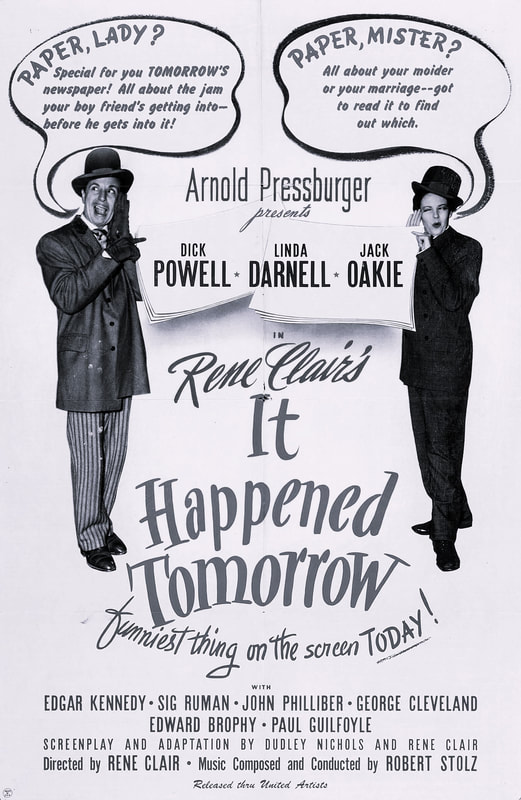 IT HAPPENED TOMORROW (1944)
IT HAPPENED TOMORROW (1944) (84 Min.) Genre: 1940 COMEDY, Transfer Quality: A
On the eve of their 50th anniversary, a couple argue about whether or not to reveal a story from the husband's past that explains how they met and came to be married. We flashback to the mid-1890's and Larry Stevens' (Dick Powell) first day on the job as a reporter for a New York newspaper -- celebrating his release from writing obituaries with a few too many beers, he and his colleagues start to listen to aging newspaper employee Pop Benson (John Philliber) talk about the past and the future, and the fact that to him they're interchangeable. Larry goes out with his friends to check out a clairvoyant act featuring Cigolini, a phony Italian mystic (Jack Oakie), and a very pretty woman assistant, Sylvia Smith (Linda Darnell). He starts to woo Sylvia, who resists his charms, before heading back to the newspaper, where he meets Pop, who hands him what he says is the newspaper he wanted -- it's only later that Larry realizes that he has tomorrow night's newspaper, and that one story concerns a robbery at the opera house. He gets to the performance that night, with Sylvia accompanying him (at first unwillingly) and witnesses the robbery, writing it up before the police can even leave the scene. His editor (George Cleveland) is ecstatic, but police inspector Mulrooney (Edgar Kennedy) wants to know how Larry knew about the robbery. Sylvia tries to protect him by claiming that she predicted it in her act, and to cover herself and Larry she predicts the drowning of a woman that night in the river. Meanwhile, Larry meets Pop again, who tells him of tomorrow's paper and its account of his attempted rescue of a drowning woman -- he later realizes that the woman is Sylvia, attempting to save him and having to fake a drowning to convince the police of her predictions; he runs to the river and dives in to rescue her. By this time, the two of them are totally involved with each other emotionally, but now Larry must face a new threat. Pop appears again and hands him a newspaper from the next day, which includes a front page story about Larry being shot and killed at the St.George Hotel. Larry vows to avoid the hotel at all costs, and even tries to get some good out of the paper by betting on the winners in five consecutive horse races that afternoon; but it seems that no matter what he does to stay away, he's destined to be at the hotel, at the appointed time.
Starring: Dick Powell, Linda Darnell, Jack Oakie, Edgar Kennedy, Edward Brophy | Directed by: René Clair
 JUDGE STEPS OUT, THE (1949)
JUDGE STEPS OUT, THE (1949) (91 Min.) Genre: 1940 COMEDY, Transfer Quality: B
The never-solved disappearance of Judge Crater in 1930 was the inspiration for RKO's The Judge Steps Out. Alexander Knox (who also co-scripted the film with director Boris Ingster) plays Bailey, a highly respected Boston magistrate who is fed up to the gills with his workload and his troublesome wife (Frieda Inescourt) and daughter (Martha Hyer). Thus, he decides to hit the road, eventually taking a job as a hash-slinger at a roadside diner. Here he is treated with compassion and understanding by his boss Peggy (Ann Sothern), who, unaware of Bailey's true identity, likes him for himself rather than his prestige. This offbeat comedy-drama manages to keep the audience guessing as to how things will turn out for everyone concerned. Filmed in 1947, The Judge Steps Out was withheld from American release for nearly two years; before making the rounds in the U.S., it was shown in Great Britain under the title Indian Summer.
Starring: Alexander Knox, Ann Sothern, George Tobias, Sharyn Moffett | Directed by: Boris Ingster
 JUNE BRIDE (1948)
JUNE BRIDE (1948) (97 Min.) Genre: 1940 COMEDY, Transfer Quality: A
June Bride is based on Feature for June, a play by Eileen Tighe and Graeme Lorimer. Bette Davis plays the businesslike editor of a fashionable woman's magazine, who plans a feature on a "typical" midwestern marriage. She assigns her aide (and former fiance) Robert Montgomery to cover the story, a task he feels is beneath him. Even so, Montgomery keeps his mouth shut as Davis and her assistants Fay Bainter and Mary Wickes descend upon the hapless family of the bride and re-arrange the household so that it will be more "appealing" to the magazine's devoted readers. Unable to stand any more of this, Montgomery devilishly upsets the apple cart: he convinces the younger sister (Betty Lynn) of the bride (Barbara Bates) to elope with the groom (Raymond Roe), for whom the sister carries a torch. Infuriated by Montgomery's intervention, Davis fires him on the spot. She later relents, realizing that the change in marital plans will make an even better story than her original concept. In so doing, Davis finally admits that she's still in love with the cheeky Montgomery. One of the better Bette Davis vehicles of the late 1940s, June Bride is chock full of brisk, bright dialogue and appealing characters. Debbie Reynolds makes her film debut in the teeny-tiny part of a friend of the bride. — Hal Erickson
Starring: Bette Davis, Robert Montgomery, Fay Bainter, Tom Tully | Directed by: Bretaigne Windust
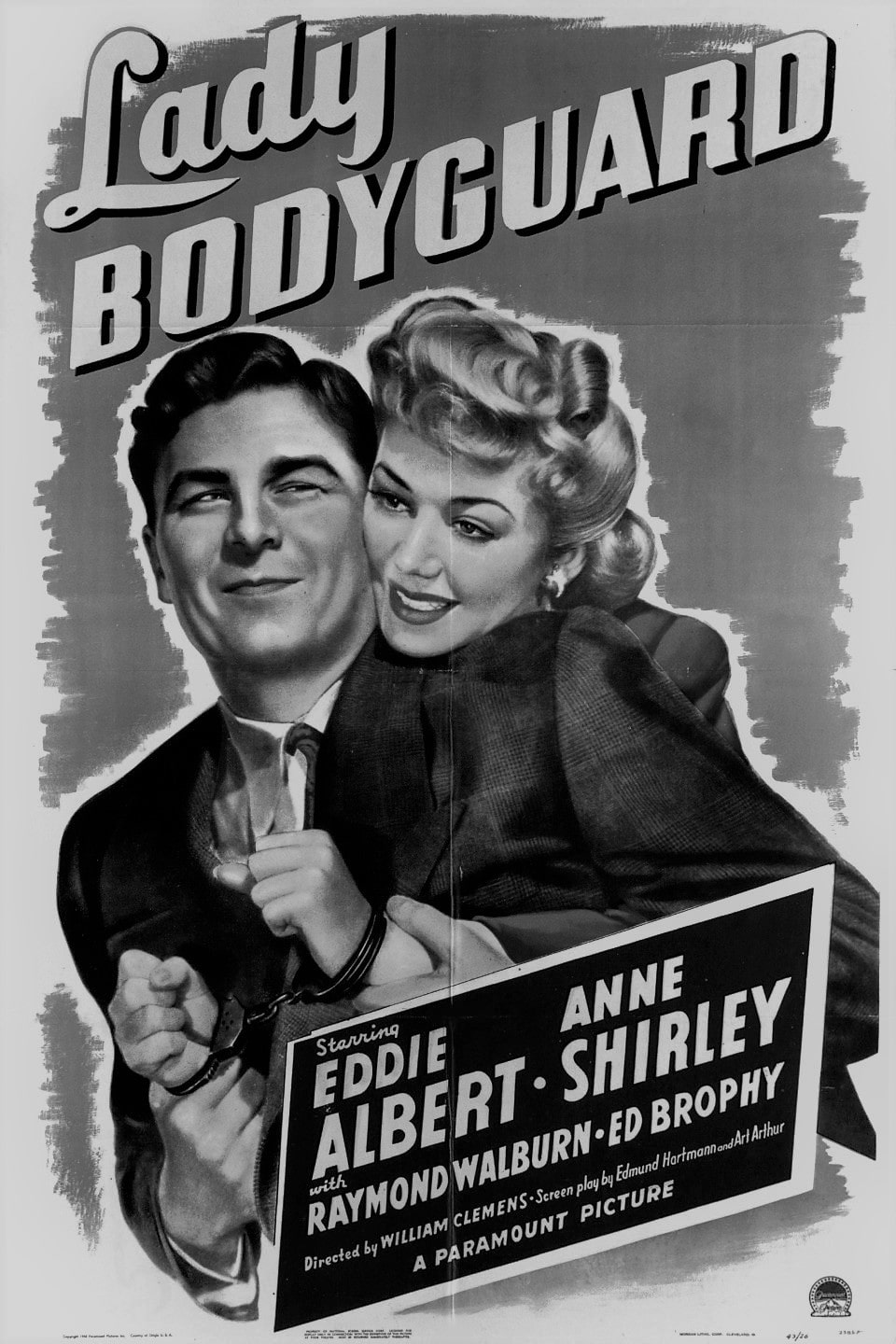 LADY BODYGUARD (1942)
LADY BODYGUARD (1942) (70 Min.) Genre: 1940 COMEDY, Transfer Quality: B
The Lady Bodyguard of the title is pretty but somewhat physically frail A. C. Baker (Anne Shirley). An advertising representative for an insurance company, A. C. gets into trouble when she okays several $1000 life-insurance policies as a publicity stunt. One of the recipients is Terry Moore (Eddie Albert), who, thanks to a typographical error, finds that he's been insured for one million dollars. Desperately, A. C. tries to talk Terry into cancelling the policy, but his avaricious beneficiaries don't want this to happen. There are laughs and thrills aplenty as a sleep-benumbed Terry pilots an airplane carrying A. C. and all of those vultures who'd benefit mightily from his demise.
Starring: Eddie Albert, Anne Shirley, Raymond Walburn, Edward S. Brophy | Directed by: William B. Clemens
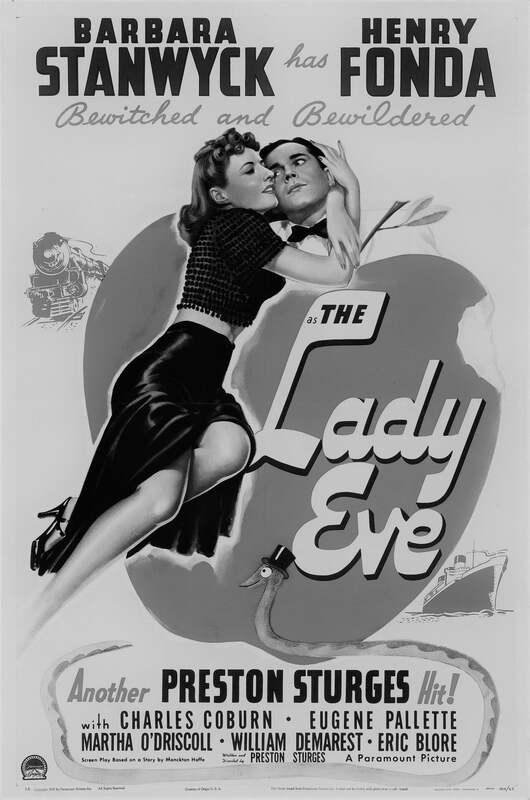 LADY EVE, THE (1941)
LADY EVE, THE (1941) (94 Min.) Genre: 1940 COMEDY, Transfer Quality: A
The Lady Eve is among the funniest films of the World War II era, and one of the few comedies whose humor has survived both cultural changes and shifting audience demographics. Directed by Preston Sturges with his usual efficiency, the battle-of-the-sexes story allows star performers Henry Fonda and Barbara Stanwyck to shine, though supporting performer William Demarest often steals the show. As was common in the censorship-laden war era, Sturges resorted to several clever sexual symbols. Fonda's character is an expert on snakes, and there is a funny moment when the audience catches the phallically suggestive book title, Are Snakes Necessary?. The dialogue is consistently bright and peppy. As Roger Ebert has pointed out, Fonda's steady, down-to-earth performance is necessary to allow Stanwyck's screwball character to shine. — Richard Gilliam
Starring: Henry Fonda, Barbara Stanwyck, Charles Coburn, William Demarest | Directed by: Preston Sturges
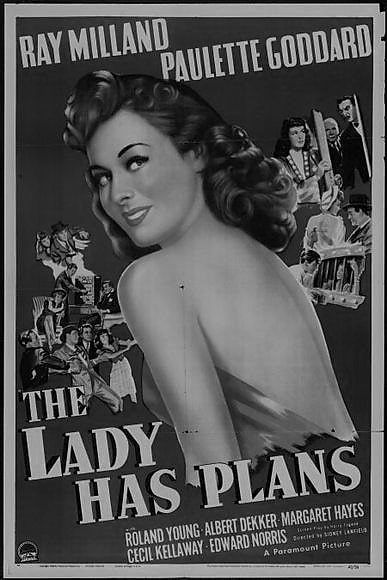 LADY HAS PLANS, THE (1942)
LADY HAS PLANS, THE (1942) (77 Min.) Genre: 1940 COMEDY, Transfer Quality: B
Long underappreciated by film buffs, The Lady Has Plans is a screwball comedy disguised as an espionage melodrama. The title character is not star Paulette Goddard, as one might assume, but Nazi agent Rita Lenox (Margaret Hayes), who sneaks into Lisbon with a secret message written on her bare back in invisible ink. Through a case of mistaken identity, perky Sidney Royce (Paulette Goddard), the assistant to globetrotting radio correspondent Kenneth Harper (Ray Milland) is presumed to be Rita Lenox. At the behest of British Intelligence chieftan Ronald Dean (Roland Young), who hopes to extract the vital information supposedly scribbled on Sidney's back, our nonplussed heroine is treated like royalty in a posh Lisbon hotel. Meanwhile, Rita, having summed up the situation, simultaneously poses as Sidney. Once he's figured out what's what, Harper manages to waylay Rita and intercept the message, but neither he nor Sidney are out of the woods yet-not if German spy chief Baron Von Kemp (Albert Dekker) has anything to say about it.
Starring: Paulette Goddard, Ray Milland, Roland Young, Albert Dekker | Directed by: Sidney Lanfield
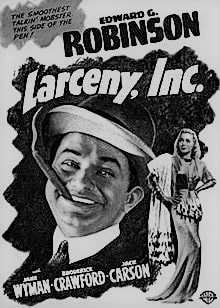 LARCENY, INC. (1942)
LARCENY, INC. (1942) (95 Min.) Genre: 1940 COMEDY, Transfer Quality: A
This very funny parody of gangster flicks centers on an incarcerated gangster who decides to reform after he is released from Sing Sing. He and his cell mate have earned a small fortune in investments and are planning to buy a dog track. Unfortunately, another prisoner eavesdrops and attempts to force the fellow to use his savings to buy a luggage store and then dig a tunnel to the bank next door so they can easily rob it. The reformer and his partner refuse. They sing a different tune when they learn that most of their money was lost by their third partner. In desperation, he buys the suitcase outlet. While he tries to deal with his many customers, the other two bumblers attempt to dig, but it's not easy because every time someone comes in, they must stop their noisy operation. More trouble follows when another gangster tries to get in on their operation. — Sandra Brennan
Starring: Edward G. Robinson, Jane Wyman, Broderick Crawford, Jack Carson, Jackie Gleason | Directed by: Lloyd Bacon
 LOVE CRAZY (1941)
LOVE CRAZY (1941) (99 Min.) Genre: 1940 COMEDY, Transfer Quality: A
William Powell and Myrna Loy re-team for this (literally) crazy screwball comedy about a happily married couple who, thanks to a visit from mother, find their marriage on the rocks and the husband committed to a mental institution. Poised to celebrate their fourth wedding anniversary, Steven (William Powell) and Susan Ireland (Myrna Loy) find their domestic bliss shattered by a visit from Susan's mother (Florence Bates). Susan's mother sprains her ankle and extends her visit, just in time to draw the wrong conclusions when her son-in-law pays a friendly visit to his old girlfriend Isobel (Gail Patrick). Susan's mother eavesdrops and reports it all to Susan, who in a jealous rage tries to make Steven jealous. But she winds up being chased through the hallway of her apartment building by half-naked archery enthusiast Ward Willoughby (Jack Carson). The couple agree on a divorce, but Steven then has second thoughts. On the advice of his lawyer, George Renny (Sidney Blackmer), Steven pretends he is insane, since the law prohibits Susan from divorcing him if Steven is mentally ill. Unfortunately, Susan is wise to his charade and has him committed to an asylum. — Paul Brenner
Starring: William Powell, Myrna Loy, Gail Patrick, Jack Carson, Elisha Cook Jr. | Directed by: Jack Conway
 MAN ALIVE (1945)
MAN ALIVE (1945) (70 Min.) Genre: 1940 COMEDY, Transfer Quality: B
Man Alive is an inventive and consistently amusing farce dominated by stars Pat O'Brien and Adolphe Menjou. The former plays Speed, a moderately successful garage owner. Wrongly convinced that his wife Connie (Ellen Drew) has fallen in love with his old friend Gordon (Rudy Vallee), Speed goes off on a toot. During a long and drunken night, he gives his clothes and his car to an old tramp named Willie the Wino (Jack Norton). With Speed as his passenger, Willie piles the car into a river; he is drowned, but Speed is rescued by showboat entrepreneur Kismet (Menjou). When the car is recovered, it is assumed that the body inside is Speed's. At first determined to prove to his grieving "widow" that he's still alive, Speed is convinced by Kismet to test Connie's loyalty, leading to a series of zany consequences. Former "Our Gang" member Carl "Alfalfa" Switzer figures prominently in the hectic closing scenes. Alas, Man Alive failed to make back its cost when first released, convincing RKO Radio to lay off such whimsical fare in the future.
Starring: Pat O'Brien, Ellen Drew, Adolphe Menjou, Rudy Vallee | Directed by: Ray Enright
 MAN WHO CAME TO DINNER, THE (1941)
MAN WHO CAME TO DINNER, THE (1941) (112 Min.) Genre: 1940 COMEDY, Transfer Quality: A
The George S. Kaufman/Moss Hart Broadway hit The Man Who Came to Dinner was inspired by the authors' mutual friend, waspish critic/author Alexander Woollcott. Generously bearded ex-Yale professor Monty Woolley, no mean curmudgeon himself, plays the Woollcott character, here rechristened Sheridan Whiteside. While on a lecture tour in Ohio, Whiteside slips on the ice outside his hosts' home; until his broken leg heals, the hosts (Grant Mitchell and Billie Burke) are forced to put up (and put up with) the imperious Whiteside. This means enduring an unending stream of Whiteside's whims, caprices and vitriolic bon mots, as well as his long-distance phone calls, eccentric guests and a variety of critters, ranging from penguins to octopi. Like the real Woollcott, Whiteside insists upon stage-managing the lives of everyone around him. He is particularly keen on discouraging a romance between his faithful secretary Maggie Cutler (top-billed Bette Davis) and local newspaper editor Bert Jefferson (Richard Travis). Once he realizes he's gone too far in this respect, Whiteside is forced to reunite the lovers. That's only one aspect of a three-ring-circus plotline that accommodates a Lizzie Bordenish axe murderess, takeoffs of Woollcott intimates Harpo Marx, Noel Coward and Gertrude Lawrence, and a general practitioner who's willing to let his patients suffer for a chance to pitch his interminable memoirs to Whiteside.
Starring: Bette Davis, Ann Sheridan, Monty Woolley, Billie Burke, Jimmy Durante | Directed by: William Keighley
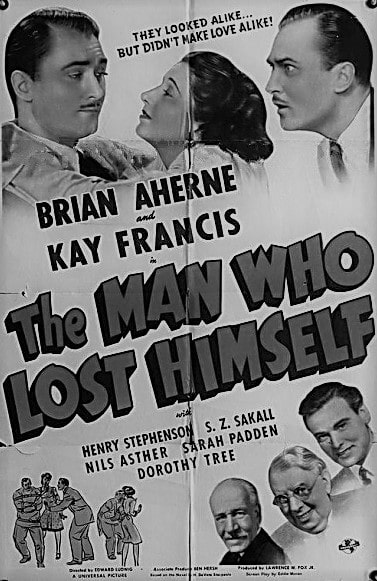 MAN WHO LOST HIMSELF, THE (1941)
MAN WHO LOST HIMSELF, THE (1941) (72 Min.) Genre: 1940 COMEDY, Transfer Quality: B
In this humorous adventure, a Puerto Rican explorer shares a drink with his oddball millionaire double. For a lark, they decide to pull a switcheroo and exchange places. Unfortunately, the millionaire is killed in a car accident. His poor grieving wife, doesn't realize that the dead man is the explorer. Meanwhile the real rich man endeavors to prove his true identity.
Starring: Kay Francis, Henry Stephenson, S.Z. Sakall, Sig Rumann | Directed by: Edward Ludwig
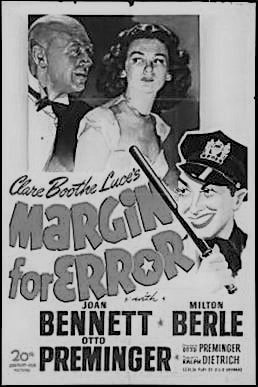 MARGIN FOR ERROR (1943)
MARGIN FOR ERROR (1943) (74 Min.) Genre: 1940 COMEDY, Transfer Quality: B
Clare Booth Luce's once-timely stage comedy Margin for Error was indifferently transferred to the screen in 1943. Milton Berle stars as Moe Finkelstein, a Jewish Brooklyn policeman assigned to guard Nazi consul Karl Baumer (Otto Preminger) in pre-WW II New York. Baumer is not only an anti-Semitic brute, but he's also a crook, siphoning off German consulate funds for his own use. His perfidy is well known by his wife Sophie (Joan Bennett), who married Baumer only to save her family from a concentration camp, and by Baumer's assistant Baron von Alvenstor (Carl Esmond). Thus, when Baumer is found dead of poison, stabbing and gunshot wounds, Sophie and the Baron are immediately suspected of murder. But Finkelstein comes to the rescue by piecing together the clues and coming up with a bizarre, but credible, solution to the crime. Having previously directed himself as Karl Baumer in the Broadway version of Margin for Error, Otto Preminger felt qualified to do the same in the film version: as a result, Preminger has no one but himself to blame for his shamelessly hammy performance.
Starring: Joan Bennett, Otto Preminger, Carl Esmond, Howard Freeman | Directed by: Otto Preminger
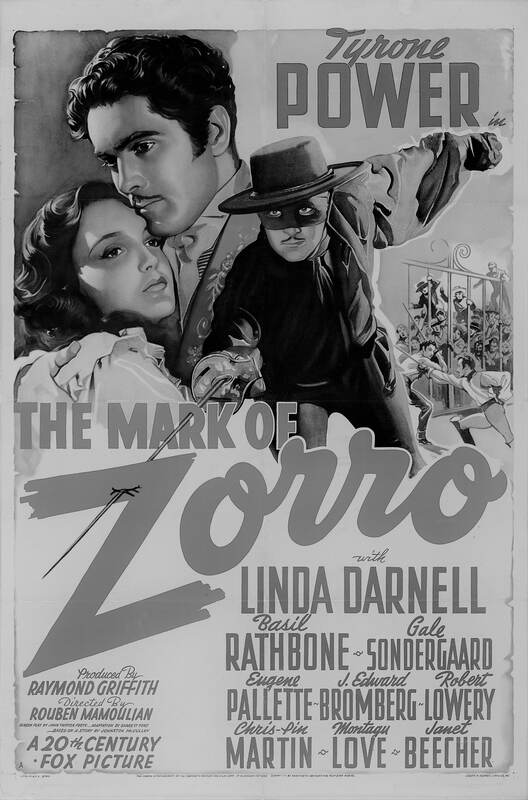 MARK OF ZORRO, THE (1940)
MARK OF ZORRO, THE (1940) (93 Min.) Genre: 1940 COMEDY, Transfer Quality: A
This is perhaps the best of the many Zorro films as Tyrone Power gives an outstanding performance as the alternately swishing and swashbuckling son of a nineteenth century California aristocrat. Champion of the oppressed, his enemy is a wicked governor portrayed by J. Edward Bromberg who, of course, has a beautiful niece that our hero loves. Basil Rathbone is a delightfully evil assistant to the governor. Based on Johnston McCulley's novel The Curse of Capistrano, it was a remake of the 1921 silent film and by far superior to all the Zorro incarnations. Interspersed with humor and one-liners but still keeping up with the highest of swashbuckling traditions, it is an action-packed story of one man standing against a corrupt, oppressive government on behalf of those less able to bear their burdens. — Tana Hobart
Starring: Tyrone Power, Linda Darnell, Basil Rathbone, Gale Sondergaard, Eugene Pallette | Directed by: Rouben Mamoulian
 MR. BLANDINGS BUILDS HIS DREAM HOUSE (1948)
MR. BLANDINGS BUILDS HIS DREAM HOUSE (1948) (94 Min.) Genre: 1940 COMEDY, Transfer Quality: A
Fed up with crowded big-city living, advertising executive Mr. Blandings (Cary Grant) decides to seek out a big, roomy house in the country. Armed with more enthusiasm than common sense, Blandings causes many a headache for his lawyer/business manager Melvyn Douglas, who tries to keep the costs within a reasonable amount. Alas, Blandings bulls ahead on his own, first purchasing an estate on the verge of collapse, then opting to build his dream house from scratch. An unpleasant legal squabble over the fact that Blandings purchased his new property without checking with the prior owners throws even more good money after bad. The construction of the new Blandings digs is slowed down to a walk by doors and windows that don't fit, plumbing that fails to function, doorknobs that break upon contact with human flesh, temperamental workmen, and various and sundry other homeowners' nightmares (if all this sounds like the much-later Tom Hanks/Shelley Long comedy The Money Pit, it only shows to go how little has changed in forty years—except, of course, for the costs of things). Attempting to keep a level head throughout the proceedings is Mrs. Blandings (Myrna Loy), though even she is guilty of pretensions and excess, especially in the classic "choice of colors" scene.
Starring: Cary Grant, Myrna Loy, Melvyn Douglas, Reginald Denny, Sharyn Moffett, Louise Beavers | Directed by: H.C.Potter
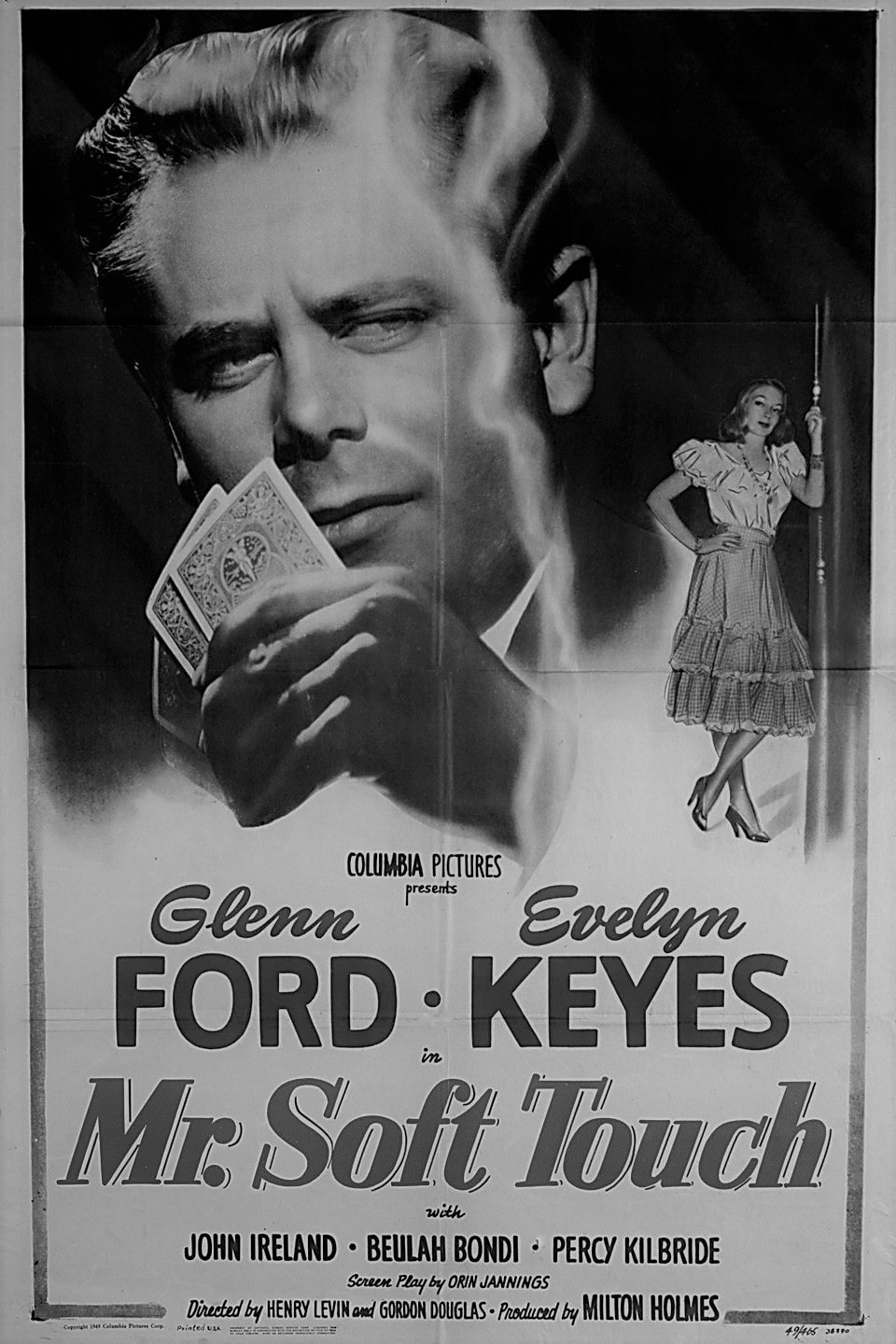 MR. SOFT TOUCH (1949)
MR. SOFT TOUCH (1949) (93 Min.) Genre: 1940 COMEDY, Transfer Quality: B
Returning from WW II, gambler Joe Miracle (Glenn Ford) discovers that his partner is dead, his gaming house has been sold, and his fortune has been claimed by others. Forced to steal back money which is rightfully his, Joe takes refuge in a settlement house run by social worker Jenny Jones (Evelyn Keyes). The girl hopes to reform Joe; he plays along, intending to skedaddle when the heat is off. Not unexpectedly, Joe begins to mellow as he learns the satisfaction of doing good for others. Meanwhile, investigative reporter "Early" Byrd (John Ireland) bides his time, hoping to expose Joe as a wanted fugitive and thus attain a big scoop. Two directors were credited for Mr. Soft Touch, though it's hard to discern where one ended and the other began. The film was released in England as House of Settlement.
Starring: Glenn Ford, Evelyn Keyes, John Ireland, Beulah Bondi | Directed by: Gordon M. Douglas, Henry Levin
 MURDER, HE SAYS (1945)
MURDER, HE SAYS (1945) (91 Min.) Genre: 1940 COMEDY, Transfer Quality: B
Though it comes on much too strong at times, Murder, He Says fully justifies its present "cult" status. Professional pollster Pete Marshall (Fred MacMurray) gets more than he bargained for when he heads to hillbilly country to investigate the disappearances of several of his colleagues. Poor Pete stumbles across the Fleagle family, who have a quaint habit of murdering anyone they consider to be a nuisance. Whip-wielding Mamie (Marjorie Main), her deceptively meek husband Mr. Johnson (Porter Hall) and her hulking, lamebrained twin sons (both played by Peter Whitney) are searching for $70,000 hidden by Bonnie Parker-like desperado Bonnie Fleagle, and they don't intend to be disturbed by any outsiders like Pete. Having previously poisoned their troublesome grandma (Mabel Paige) with a curious substance that causes its victims to glow in the dark, Mamie and her brood try to dispatch Pete in the same manner, leading to an uproarious slapstick setpiece involving an elaborate "Lazy Susan" table. Complicating matters is the arrival of two different women (Helen Walker, Barbara Pepper) claiming to be the long-lost Bonnie Fleagle. Jean Heather costars as Elany Fleegle, the only sympathetic (but no less crack-brained) member of the killer brood. Its comedy content aside, Murder, He Says would be memorable for its eye-popping split-screen photography, thoroughly convincing the audience that Peter Whitney is indeed two different people. — Hal Erickson
Starring: Fred MacMurray, Helen Walker, Marjorie Main, Porter Hall | Directed by: George Marshall
 MY FAVORITE BLONDE (1942)
MY FAVORITE BLONDE (1942) (78 Min.) Genre: 1940 COMEDY, Transfer Quality: A
Each of Bob Hope's "My Favorite" films (My Favorite Blonde, My Favorite Brunette, My Favorite Spy) was, by accident or design, a parody of a dead-serious movie genre. 1942's My Favorite Blonde, for example, was a takeoff of Alfred Hitchcock in general and Hitchcock's 39 Steps in particular. Two-bit vaudeville entertainer Hope gets mixed up with gorgeous blonde British-spy Madeline Carroll. The "maguffin" (Hitchcock's nickname for "gimmick") which ties the two stars together is a ring which contains the microfilmed plans for a revolutionary new bomber. Hope and Carroll are forced to take it on the lam when Hope is framed for murder by Nazi-agents Gale Sondergaard, George Zucco et. al. Highlights include Hope eluding capture by impersonating a famed psychologist (watch for Carl "Alfalfa" Switzer as Hope's most contentious "patient"). Madeline Carroll also got several opportunities to shine comedically, especially when she lapsed into cloying baby talk while posing as Hope's wife. Bob Hope was hesitant to work with My Favorite Blonde director Sidney Lanfield, having heard of Lanfield's reputation as an on-set dictator. However, the two got along so swimmingly that they would collaborate on such future top-notch Hope farces as Let's Face It (1943) and The Lemon Drop Kid (1951). — Hal Erickson
Starring: Bob Hope, Madeleine Carroll, Gale Sondergaard, George Zucco | Directed by: Sidney Lanfield
 MY FAVORITE BRUNETTE (1947)
MY FAVORITE BRUNETTE (1947) (85 Min.) Genre: 1940 COMEDY, Transfer Quality: A
Just as Bob Hope's My Favorite Blonde (1942) was a takeoff on Alfred Hitchcock, Hope's My Favorite Brunette was a lampoon of the noirish "hard-boiled detective" school popularized by Raymond Chandler. Awaiting execution on death row, Hope tells the gathered reporters how he got into his present predicament. It seems that Hope was once a baby photographer, his office adjacent to the one leased by a private detective (played in an amusing unbilled cameo by Alan Ladd). While hanging around the p.i.'s office, Hope is mistaken for the detective by beautiful client Dorothy Lamour. She hires Hope to search for her missing uncle, and also entrusts him with a valuable map. Hope's diligent (if inept) sleuthing takes him to a shady rest sanitarium, where he runs afoul of lamebrained henchman Lon Chaney Jr. and sinister, knife-throwing Peter Lorre. Both are in the employ of attorney Charles Dingle, who is responsible for the disappearance of Lamour's uncle. Escaping the sanitarium with Lamour in tow, Hope follows the trail of evidence to noted geologist Reginald Denny. The geologist is murdered, and Hope is accused of the crime. For reasons unknown, Lamour never shows up to testify on his behalf, and he is sentenced to the chair. Just before he takes the "last walk", Lamour rushes in, explain what has detained her, and delivers enough evidence to clear Hope. Hope is free to enjoy the caresses of the luscious Lamour—much to the dismay of death-row guard Bing Crosby! Three years after the release of My Favorite Brunette, Hope starred in yet another "My Favorite" flick: My Favorite Spy, a spoof of Casablanca-type espionage films. — Hal Erickson
Starring: Bob Hope, Dorothy Lamour, Peter Lorre, Lon Chaney, Jr, Alan Ladd | Directed by: Elliott Nugent
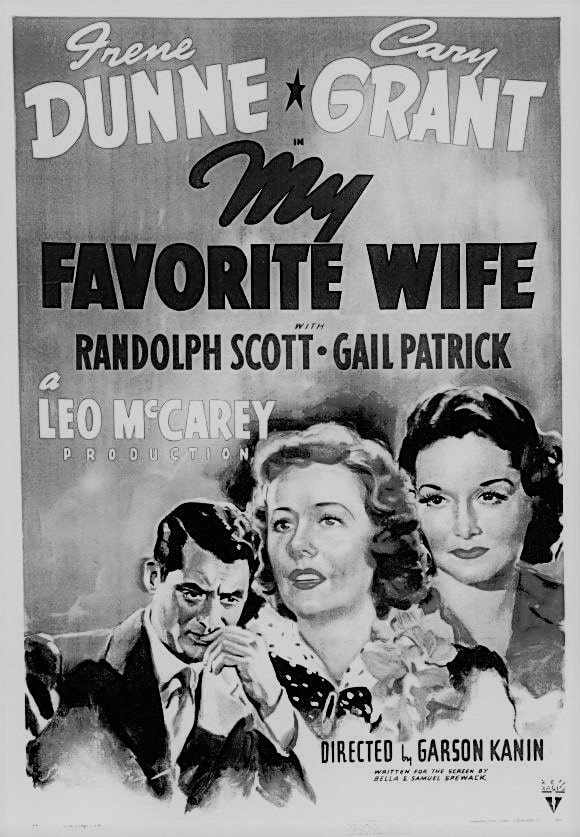 MY FAVORITE WIFE (1940)
MY FAVORITE WIFE (1940) (88 Min.) Genre: 1940 COMEDY, Transfer Quality: A
Leo McCarey was supposed to both produce and direct My Favorite Wife, but an illness forced him to relinquish the director's chair to Garson Kanin, who did a splendid job. This hilarious retread of the old "Enoch Arden" legend stars Irene Dunne as Ellen, who returns home to her husband Nick (Cary Grant) and children Tim (Ann Shoemaker) and Chinch (Mary Lou Harrington) after being marooned on a desert island for seven years. Thing of it is, Ellen has been declared legally dead, and Nick has taken unto himself a second wife, the bitchy Bianca (Gail Patrick). Upon discovering that Ellen is still alive, Nick is on the verge of a tender reunion-until it discovers that she spent those seven lost years in the company of handsome Mr. Barkett (Randolph Scott). The superb supporting cast includes Granville Bates as a flummoxed judge, Chester Clute as a meek shoe salesman whom Ellen tries to pass off as Barkett, and Donald MacBride as a beetle-browed honeymoon-hotel clerk. My Favorite Wife was remade in 1963 as Move Over Darling, in which Irene Dunne and Cary Grant were replaced by Doris Day and James Garner. — Hal Erickson
Starring: Irene Dunne, Cary Grant, Randolph Scott, Gail Patrick | Directed by: Garson Kanin
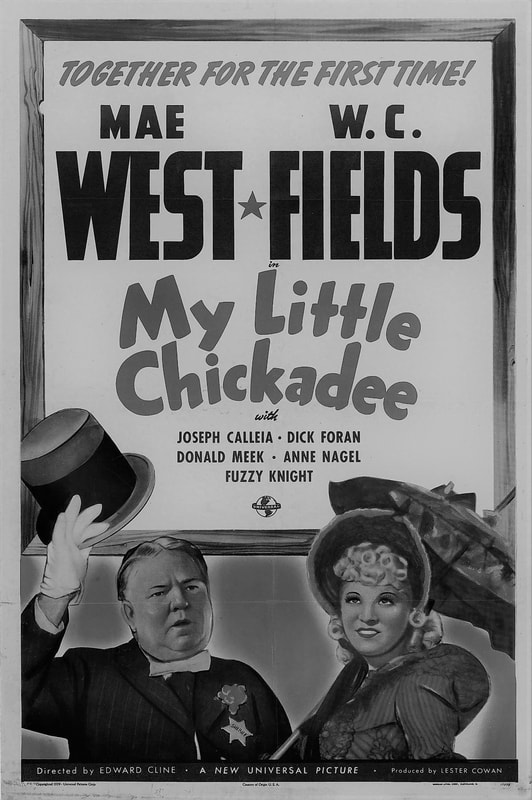 MY LITTLE CHICKADEE (1940)
MY LITTLE CHICKADEE (1940) (91 Min.) Genre: 1940 COMEDY, Transfer Quality: A
What should have been a once-in-a-lifetime laugh riot, My Little Chickadee turns out to be an amusing but surprisingly routine comedy. Teaming Mae West and W.C. Fields was an inspired idea, but the coming up with it seems to have taken all of the inspiration out of the two stars. The script they are credited with co-writing has plenty of catchy one-liners and the requisite zingers, but it also has arid spaces where the jokes don't really land. And the plotting is rather more involved than necessary, with the mystery bandit subplot frequently getting in the way of the fun. Director Edward F. Cline's direction is more of the point-and-shoot kind, but that really shouldn't matter; in a star team-up like this, one doesn't want a director getting in the way and cluttering things up. Unfortunately, the chemistry that the uniquely gifted West and Fields should have is largely missing. Many of their scenes together are shot in alternating close-ups, and during these shots, one never believes that the star on camera is communicating with another character at all. Fortunately, West and Fields do have numerous opportunities to work their magic as individuals, and here they deliver like gangbusters - West's visual annoyance at a couple of stray arrows that come her way are by themselves worth the price of admission, and Fields's bathtub sequence is another winner. Chickadee is a missed opportunity, but it has enough going for it to make it worth catching. — Craig Butler
Starring: Mae West, W.C. Fields, Joseph Calleia, Dick Foran, Anne Nagel | Directed by: Edward F. Cline
 NEVER GIVE A SUCKER AN EVEN BREAK (1941)
NEVER GIVE A SUCKER AN EVEN BREAK (1941) (70 Min.) Genre: 1940 COMEDY, Transfer Quality: A
W.C. Fields heads to Esoteric studios to pitch a story idea to producer Franklin Pangborn. The producer wants to make a conventional romantic musical starring Fields' niece, teen-aged soprano Gloria Jean, but "The Great Man" has other ideas. As Pangborn sits in dumbfounded silence, Fields unravels an incoherent farrago which begins with him travelling to a Russian colony in Mexico—by way of an airliner with an open observation platform. Fields dives from the plane when his precious flask of gin falls overboard; he lands safely at the mountaintop mansion of the formidable Mrs. Hemoglobin (Margaret Dumont). Playing a kissing game with Hemoglobin's beauteous daughter (Susan Miller), who has never seen a man before, Fields decides to make a quick exit when Mama wants to get in on the game too. Reunited with Gloria Jean in the Russian colony, Fields learns that Mrs. Hemoglobin is worth millions, so he climbs back up the mountain, ignoring such obstacles as a displaced African gorilla. Disposing of his rival Leon Errol, Fields is about to wed Mrs. Hemoglobin, but is talked out of it at the last moment by Gloria Jean. At this point in the narrative, producer Pangborn can stand no more. He tells Fields to take his nonsensical screenplay and vacate the premises. After a brief episode at a soda fountain ("This scene was supposed to be in a barroom, but the censors made us cut it out"), Fields drives off to new adventures with his niece—but not before a zany slapstick car-chase finale, prompted by Fields' mistaken belief that he's rushing a corpulent middle-aged lady to the maternity hospital. W. C. Fields' original screenplay for Never Give a Sucker an Even Break (written under the fanciful pseudonym of Otis Criblecoblis) made a lot more sense than what ended up on screen, but Fields' extended absences from the studio, coupled with Universal's desire to reshape the film into a vehicle for their new star Gloria Jean, necessitated a complete restructuring of the plot. While hardly Fields' best or most representative film, Sucker is an excellent example of the sort of nonsensical "nut" humor in vogue in 1941 thanks to Olsen and Johnson's Hellzapoppin'. And, occasionally, the film stands still long enough to allow W. C. Fields to mutter a priceless aside or toss off a perfectly timed double-take. — Hal Erickson
Starring: W.C. Fields, Gloria Jean, Leon Errol, Margaret Dumont, Anne Nagel | Directed by: Edward F. Cline
 NIGHT IN CASABLANCA, A (1946)
NIGHT IN CASABLANCA, A (1946) (85 Min.) Genre: 1940 COMEDY, Transfer Quality: A
After a five-year absence, the Marx Brothers returned to the screen in the independently-produced effort A Night in Casablanca. Originally conceived as a parody of Casablanca (with character names like "Humphrey Bogus" and "Lowen Behold"), the film emerged as a spoof of wartime melodramas in general. Someone has been methodically murdering the managers of the Hotel Casablanca, and that someone is escaped Nazi war criminal Heinrich Stubel (Sig Ruman). Disguised as a Count Pfefferman, Stubel intends to reclaim the stolen art treasures that he's hidden in a secret room somewhere in the hotel, and the only way he can do this undetected is by bumping off the managers and taking over the hotel himself. The newest manager of Hotel Casablanca is former motel proprietor Ronald Kornblow (Groucho Marx), who, blissfully unaware that he's been hired only because no one else will take the job, immediately takes charge in his own inimitably inept fashion. Corbacchio (Chico Marx), owner of the Yellow Camel company, appoints himself as Kornblow's bodyguard, aided and abetted by Stubel's mute valet Rusty (Harpo Marx). In his efforts to kill Kornblow, Stubel dispatches femme fatale Beatrice Reiner (Lisette Verea) to romance the lecherous manager, leading to a hilarious recreation of a key comedy sequence in the Marxes' earlier A Day at the Races. Arrested on a trumped-up charge, Kornblow, Corbacchio and Rusty escape in time to foil Stubel and his stooges.
Starring: The Marx Brothers, Lisette Verea, Charles Drake | Directed by: Archie Mayo
 NOTHING BUT THE TRUTH (1941)
NOTHING BUT THE TRUTH (1941) (90 Min.) Genre: 1940 COMEDY, Transfer Quality: B
In this version of the oft-filmed stage play by James Montgomery, Nothing But the Truth stars Bob Hope as an up and coming young stockbroker working in Florida. He makes a bet with his coworkers that he can tell nothing but the absolute truth for 24 hours, and the other bettors are determined to keep tabs on him to make sure he doesn't falter. The rest of the action takes place aboard a yacht, where Hope's undiplomatic truthfulness gets him into hot water with a wealthy client, several other influential people, and his girl friend (Paulette Goddard). Hope's coworkers contrive to trick Hope into losing his wager, but African-American valet Willie Best foils their scheme. The picture ends with Hope having to explain his curious behavior for the past 24 hours without offending anyone (P.S.: he pulls it off). Nothing But the Truth was Paramount's third Bob Hope/Paulette Goddard costarring effort, all three based on past stage successes. The film lay unseen for years after its 1941 release due to legal tangles, but was finally made available again through the auspices of film historian Leonard Maltin in the early 1980s.
Starring: Bob Hope, Paulette Goddard, Edward Arnold, Glenn Anders | Directed by: Elliott Nugent
 NOTHING BUT TROUBLE (1944)
NOTHING BUT TROUBLE (1944) (69 Min.) Genre: 1940 COMEDY, Transfer Quality: A
The second of Laurel & Hardy's two MGM starring films, Nothing But Trouble casts Stan and Ollie as, respectively, an unemployed butler and chef. Despite their inherent ineptitude, there's a wartime servant shortage, so the boys are hired by flighty dowager Mrs. Hawkley (Mary Boland), who hopes to impress visiting dignitaries from the kingdom of Orlandia. While purchasing food for Mrs. Hawkley's dinner party, Stan and Ollie meet a likeable child named Chris (David Leland)-who unbeknownst to them is Orlanda's young monarch-in-exile King Christopher. The boy's uncle, Prince Saul (Philip Merivale), intends to assassinate Chris and take (Peter Cookson) into helping her solve the case, despite his protestations and reminders of what happened "last time". It turns out that the killings are tied in with a jewel theft, a fact that comes out during the film's slapsticky finale. Tim Ryan, who also cowrote the script, is back as long-suffering Inspector Clancy, who'd like to arrest Kitty for the murders if only to shut her up for a few minutes. A note of caution: the scared-reaction humor of black porter Jeff (Shelton Brooks) may not play too well with racially-sensitive viewers. — Hal Erickson
Starring: Stan Laurel, Oliver Hardy, Mary Boland, Philip Merivale | Directed by: Sam Taylor
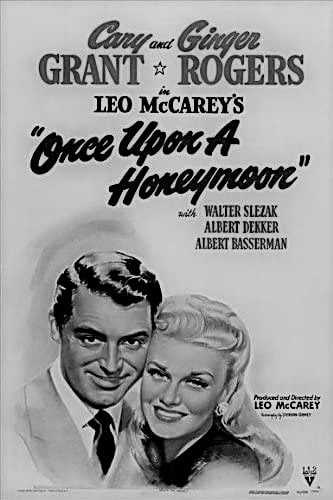 ONCE UPON A HONEYMOON (1942)
ONCE UPON A HONEYMOON (1942) (116 Min.) Genre: 1940 COMEDY, Transfer Quality: A
The surrealistic opening sequence, featuring a WW2 calendar as written "by A. Hitler", should be indication enough that Once Upon a Honeymoon is no ordinary lighthearted romantic trifle. Ginger Rogers plays Katie, an American chorus girl who seeks to better herself by marrying titled European Baron von Luber (Walter Slezak), despite the warnings of reporter Pat (Cary Grant). Katie thinks Pat is just jealous, but both he and the audience are aware that Von Luber is secretly a high-ranking Nazi, whose "unofficial" visits to Czechoslovakia, Poland and France precipitate the German invasions of those countries. When Katie wises up, she agrees to help counterespionage agent LeBlanc (Albert Dekker) in his efforts to stop Von Luber before he can reach New York-and along the way, she falls in love with the ubiquitous Pat. The bizarre ending, in which one of the main characters is casually murdered, is played for laughs, as if WW2 is merely fodder for a screwball comedy. In the film's most unsettling scene, Katie and Pat, mistaken for Jews, are briefly interred in a Polish concentration camp; their outrage over this treatment seems to be founded not on Germany's crimes against humanity, but over the fact that the Gestapo would have the audacity to incarcerate two non-Jewish Americans! A curious and often tasteless misfire from producer-director Leo McCarey, One Upon a Honeymoon is an undeniably fascinating historical artifact. — Hal Erickson
Starring: Ginger Rogers, Cary Grant, Walter Slezak, Albert Dekker | Directed by: Leo McCarey
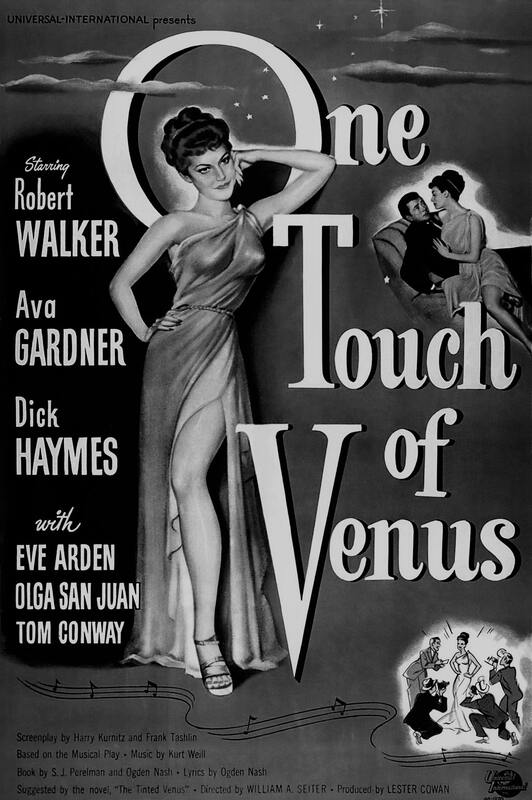 ONE TOUCH OF VENUS (1948)
ONE TOUCH OF VENUS (1948) (82 Min.) Genre: 1940 COMEDY, Transfer Quality: A
The spirit of love is back, and she's working in retail in this bubbly romantic musical comedy. Eddie Hatch (Robert Walker) is a window dresser at a large department store; he's become especially fond of one of his mannequins who looks like the sort of girl he'd like to meet, and one night he impulsively gives the dummy a kiss. To his tremendous surprise, the mannequin comes to life, and it turns out to inhabit the spirit of Venus, the Goddess of Love (Ava Gardner). Suddenly, romance is in the air as Eddie's fellow employees throw caution to the wind and finally express their infatuations with their co-workers; however, Eddie is too intimidated to follow through on his feelings for Venus, even though she'll only be in human form for 24 hours. Adapted from a popular Broadway musical, One Touch of Venus features a number of memorable songs by Kurt Weill and Ogden Nash, including "Speak Low" and "The Trouble with Women," though a number of other songs they wrote for the stage production were replaced for the film.
Starring: Robert Walker, Ava Gardner, Dick Haymes, Eve Arden, Anne Nagel | Directed by: William Seiter
 OUT OF THE BLUE (1947)
OUT OF THE BLUE (1947) (86 Min.) Genre: 1940 COMEDY, Transfer Quality: A
If Eagle-Lion's Out of the Blue looks more like a slick Warner Bros. product at times, it's because the film was peopled by former Warners personnel, both in front of and behind the cameras. George Brent and Carole Landis play the Earthleighs, tenants in a roomy Greenwich Village apartment. When Mr. Earthleigh isn't being nagged by his domineering bride, he's enmeshed in a feud with his neighbor, loose-living artist David (Turhan Bey). During his wife's absence, Earthleigh makes the mistake of inviting Olive (Ann Dvorak), a glamorous interior decorator who's somewhat the worse for drink, to his apartment. When Olive passes out on his floor, Earthleigh assumes that she's dead-and in the course of subsequent events, so does everyone else. Adding to the general zaniness is Deborah (Virginia Mayo), one of David's sexier models, who weaves in and out of the proceedings at the most inopportune moments, and a huge, cantankerous canine named Rabelais. Despite some formidable competition, the comedy honors in Out of the Blue are won hands-down by Ann Dvorak, in a truly offbeat performance.
Starring: Turhan Bey, George Brent, Ann Dvorak, Carole Landis, Virginia Mayo | Directed by: Leigh Jason
 PHILADELPHIA STORY, THE (1940)
PHILADELPHIA STORY, THE (1940) (112 Min.) Genre: 1940 COMEDY, Transfer Quality: A
We open on Philadelphia socialite C.K. Dexter Haven (Cary Grant) as he's being tossed out of his palatial home by his wife, Tracy Lord (Katharine Hepburn). Adding insult to injury, Tracy breaks one of C.K.'s precious golf clubs. He gallantly responds by knocking her down on her million-dollar keester. A couple of years after the breakup, Tracy is about to marry George Kittridge (John Howard), a wealthy stuffed shirt whose principal recommendation is that he's not a Philadelphia "mainliner," as C.K. was. Still holding a torch for Tracy, C.K. is galvanized into action when he learns that Sidney Kidd (Henry Daniell), the publisher of Spy Magazine, plans to publish an exposé concerning Tracy's philandering father (John Halliday). To keep Kidd from spilling the beans, C.K. agrees to smuggle Spy reporter Macauley Connor (James Stewart) and photographer Elizabeth Imbrie (Ruth Hussey) into the exclusive Lord-Kittridge wedding ceremony. How could C.K. have foreseen that Connor would fall in love with Tracy, thereby nearly lousing up the nuptials? As it turns out, of course, it is C.K. himself who pulls the "louse-up," reclaiming Tracy as his bride. A consistently bright, bubbly, witty delight, The Philadelphia Story could just as well have been titled "The Revenge of Katharine Hepburn." Having been written off as "box-office poison" in 1938, Hepburn returned to Broadway in a vehicle tailor-made for her talents by playwright Philip Barry. That property, of course, was The Philadelphia Story; and when MGM bought the rights to this sure-fire box-office success, it had to take Hepburn along with the package -- and also her veto as to who her producer, director, and co-stars would be. Her strategy paid off: after the film's release, Hepburn was back on top of the Hollywood heap. While she didn't win the Oscar that many thought she richly deserved, the little gold statuette was bestowed upon her co-star Stewart, perhaps as compensation for his non-win for 1939's Mr. Smith Goes to Washington. Donald Ogden Stewart (no relation to Jimmy) also copped an Oscar for Best Adapted Screenplay. The Philadelphia Story was remade in 1956 with a Cole Porter musical score as High Society.
Starring: Cary Grant, Katharine Hepburn, James Stewart, Ruth Hussey, Roland Young | Directed by: George Cukor
 REMEMBER THE NIGHT (1940)
REMEMBER THE NIGHT (1940) (94 Min.) Genre: 1940 COMEDY, Transfer Quality: B
One of the finest -- and least known -- Christmas movies, Remember the Night is also arguably director Mitchell Leisen's best film. It benefits immensely from a sterling Preston Sturges screenplay that manages to mine all the emotion and sentiment from its "different worlds" story without every falling into bathos. Needless to say, the screenplay is also chock-full of the incisive wit, ear for a nifty turn of phrase, and insightful character studies that are a trademark of Sturges' later classic comedies. He is one of the few writers of the period who could have skated as close to the edge of soapy melodrama as the twin homecoming sequences without falling over. The film's heartwarming tugs are genuine, achieved with a bare minimum of manipulation. Leisen deserves credit for serving the material so adeptly. If the first courtroom scene is a bit awkward, it's the only place in the film where the director falters. He is helped, of course, by the irreplaceable Barbara Stanwyck. As usual, the actress is curiously radiant, a tough girl whose softness is totally believable. Fred MacMurray is a perfect foil for her, strong but tender, a man whose niceness is never cloying and whose toughness is tempered with mercy. The rest of the cast gives excellent support, especially Beulah Bondi, Elizabeth Patterson, and Sterling Holloway. An excellent film, Night deserves a place in the holiday pantheon beside such better-known titles as Miracle on 34th Street and The Bells of St. Mary's.
Starring: Barbara Stanwyck, Fred MacMurray, Beulah Bondi, Elizabeth Patterson | Directed by: Mitchell Leisen
 RIO RITA (1942)
RIO RITA (1942) (91 Min.) Genre: 1940 COMEDY, Transfer Quality: A
MGM's Rio Rita is an in-name-only remake of the 1929 RKO Radio musical blockbuster, itself based on the long-running Ziegfeld Broadway extravaganza. Bud Abbott & Lou Costello take over from the original film's Burt Wheeler & Robert Woolsey as the comedy leads, while Kathryn Grayson (in her first picture) and John Carroll replace the 1929 version's Bebe Daniels and John Boles. The original plot about an elusive bandit chieftan called the Kinkajou has been jettisoned in favor of an updated melange involving radio broadcasts and Nazi saboteurs. Abbott and Costello are cast as Doc and Wishy, two pet-store employees stranded in Texas. Hoping to return to New York, our heroes stow away in the trunk of the car owned by radio star Ricardo Montera (John Carroll), only to discover that Ricardo is on his way to his home town near the Hotel Vista del Rio, there to renew his acquaintance with childhood sweetheart Rita Winslow (Kathryn Grayson). Unbeknownst to Rita, her ranch become the headquarters for a nest of German spies, headed by hotel manager Craindall (Tom Conway), who've hidden their miniature shortwave radios in a crate of apples. Thanks to well-meaning Wishy, the message-receiving fruit is ingested by dogs and donkeys, leading to an unending stream of "talking animal" gags. Given jobs on the ranch, Wishy and Doc quickly run afoul of the Nazis, but Wishy saves the day with a bit of uncharacteristic quick thinking involving the local Texas Rangers. Only a few traces of the original Rio Rita remain, including two songs and the classic Wheeler - Woolsey "drunk" routine. The new songs by Harold Arlen and E. Y. Harburg are pleasant if unmemorable, attractively performed by Kathryn Grayson and John Carroll. When all is said and done, the film's greatest strength is Abbott & Costello, making the first of three visits to MGM. Highlights include such verbal exchanges as "Pike's Peak" and "Bet you ten dollars you're not there", and a handful of well-crafted slapstick routines involving an auto turntable, a gigantic washing machine and an elusive time bomb. — Hal Erickson
Starring: Bud Abbott, Lou Costello, Kathryn Grayson, John Carroll, Patricia Dane | Directed by: S. Sylvan Simon
 RIVER'S END (1940)
RIVER'S END (1940) (69 Min.) Genre: 1940 COMEDY, Transfer Quality: A
Previously filmed in 1920 and 1931, James Oliver Curwood's River's End was given a third go-round by Warner Bros. in 1940. Dennis Morgan plays a dual role as falsely accused murderer John Keith and stalwart Canadian mountie Sgt. Conniston. When Conniston is accidently killed, Keith takes his place, and while in Redcoat guise manages to solve the murder for which he was accused. George Tobias dominates the proceedings as French-Canadian Andy Dijon, who spends most of his time trying to get into trouble to get out of an unwanted marriage. The heroine is Elizabeth Earl, of whom little was heard after River's End ran its course; the same could not be said of supporting player James Stephenson, who would skyrocket to stardom in 1940 by virtue of his performance in William Wyler's The Letter. — Hal Erickson
Starring: Dennis Morgan, George Tobias, Elizabeth Earl, Victor Jory, Charles Bickford | Directed by: Ray Enright
 ROAD TO MOROCCO (1942)
ROAD TO MOROCCO (1942) (82 Min.) Genre: 1940 COMEDY, Transfer Quality: A
The fact that the audience accepts a camel talking to them is proof that Road to Morocco achieves the same degree of priceless and inexplicable lunacy that can only be found in the best Warner Bros. cartoons. The third of the "Road" movies, Morocco is unarguably the highlight of this daffy, delightful series; the rapid-fire wisecracks, ridiculous situations, comic buffoonery of the stars, get-out-of-the-way-and-just-shoot direction of David Butler, and general air of zaniness come together in a way that makes Road to Morocco something very special. Although none of the individual participants have the innate, inspired zaniness that one associates with the Marx Brothers, somehow their talents coalesce in this picture into something very close to the organized chaos of which the brothers were masters. Even the songs are good (not always the case in the "Road" shows), with the title song featuring some felicitous lyrics, and the big ballad, "Moonlight Becomes You," is genuinely romantic. Bob Hope and Bing Crosby are their usual selves, only deliriously more so, and Dorothy Lamour plays off of them with effortless skill. If there are weak links in the supporting cast (such as Anthony Quinn's one-note villain), it doesn't really matter. Road to Morocco is so "right" that its flaws don't matter. — Craig Butler
Starring: Bing Crosby, Bob Hope, Dorothy Lamour, Anthony Quinn | Directed by: David Butler
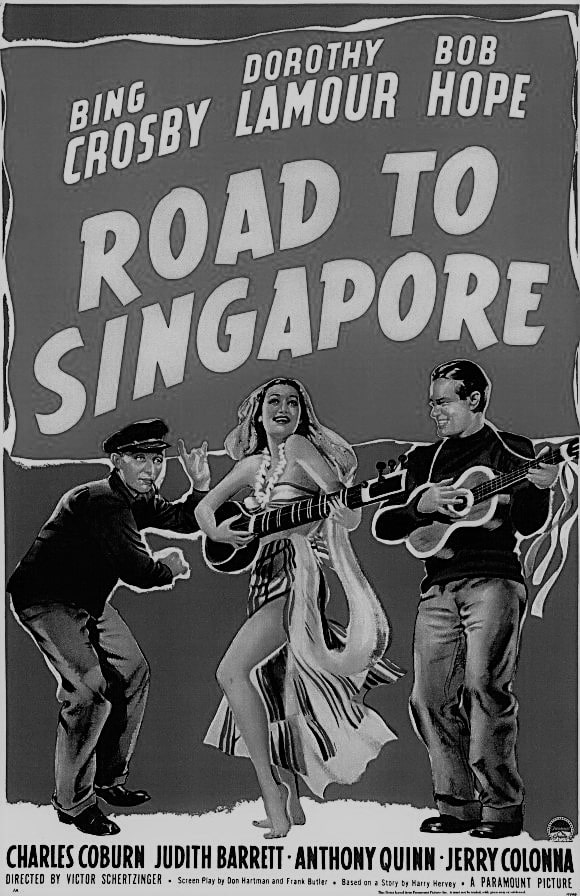 ROAD TO SINGAPORE (1940)
ROAD TO SINGAPORE (1940) (85 Min.) Genre: 1940 COMEDY, Transfer Quality: A
The story goes that such stars as Fred MacMurray, Jack Oakie and Burns & Allen had turned down The Road to Singapore before the leading roles went to Bing Crosby and Bob Hope. More conventionally structured than future "Road" efforts, the film casts Crosby as Josh Mallon, the irresponsible son of shipping magnate Joshua Mallon IV (Charles Coburn). Though the elder Mallon wants his son to enter the family business and marry longtime fiancee Gloria Wycott (Judith Barrett), Josh would rather pal around with his carefree sailor buddy Ace Lannigan (Bob Hope). On the eve of his wedding, Josh escapes with Ace to Singapore, where the two of them cook up a get-rich-quick scheme involving a highly unreliable spot remover. The boys' friendship is strained when they both fall in love with cabaret dancer Mima (Dorothy Lamour), who is on the lam from her jealous partner Caesar (Anthony Quinn). Hiding out from the authorities, the three protagonists wind up in the midst of a native ceremony, where Ace and Mima rescue Josh from a hasty marriage to a local temptress. When Gloria shows up to drag Josh back to the altar, Mima nobly gives him up, pretending to be in love with Ace. Eventually, however, big-hearted Ace realizes that Mima belongs with Josh, and thus concocts another scheme to lure his pal back to the Far East. Though many of the earmarks of the "Road" series are evident in Road to Singapore (the "patty-cake" bit, the presence of such guest stars as Hope's radio stooge Jerry Colonna, etc.), the film lacks the spontaneous quality of the later Hope-Crosby-Lamour starrers. Even so, it's an awful lot of fun, especially when Bob and Bing team up on the novelty number "Captain Custard" and Dorothy croons her requisite "moon and stars" romantic ballads. — Hal Erickson
Starring: Bing Crosby, Dorothy Lamour, Bob Hope, Charles Coburn | Directed by: Victor Schertzinger
 ROAD TO ZANZIBAR (1941)
ROAD TO ZANZIBAR (1941) (92 Min.) Genre: 1940 COMEDY, Transfer Quality: A
The second Bing Crosby/Bob Hope "Road" picture casts Crosby as a penny-ante sideshow promoter and Hope as Crosby's only client, "Fearless Frazier." Under Crosby's tutelage, Hope has been shot from a cannon, zapped in an electric chair and nearly strangled by an octopus. Now they're practically broke and stranded on the African coast. Crosby spends the last of their money to spring helpless Dorothy Lamour from a native slave market. Actually, Lamour and her pal Una Merkel are scamming Crosby and Hope to finance a safari across Africa, so that Lamour can link up with her wealthy fiance in Zanzibar. En route through the deepest, darkest jungle, both Hope and Crosby fall in love with Lamour. But when they find out they're being taken for chumps, the boys leave the safari and strike out on their own. Captured by cannibals, the boys try and fail to win their freedom by having Hope wrestle a particularly grumpy gorilla. Making their escape after teaching the natives their time-honored "Patty Cake" routine, they head for Zanzibar. Once again, Crosby spends his ready money to spring Lamour from her captured-by-slavers con game, obliging Hope, Crosby, Lamour and Merkel to try to earn passage money home by staging a "sawing the lady in half" routine for the locals. Crosby: "Are you sure you know what you're doing?" Hope: "If I don't, one of us is going back half fare." Like the earlier Road to Singapore, Road to Zanzibar sticks too closely to the script and plot to allow those inveterate adlibbers Hope and Crosby free reign. Still, there are some choice moments: our favorite bit occurs when Crosby comments to Lamour on the artificiality of movie musicals—whereupon the sound of an orchestra pops up out of nowhere. — Hal Erickson
Starring: Bing Crosby, Bob Hope, Dorothy Lamour, Una Merkel | Directed by: Victor Schertzinger
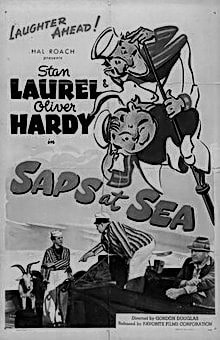 SAPS AT SEA (1940)
SAPS AT SEA (1940) (57 Min.) Genre: 1940 COMEDY, Transfer Quality: B
In their last film for Hal Roach, Stan Laurel and Oliver Hardy play employees at the Sharp and Pierce Horn Factory, where the workers tend to go beserk at a rate of one per hour. Driven crazy by the cacophonous G-minor horn, poor Ollie begins to tear the factory apart, screaming "Horns to the left of me! Horns to the right of me! Horns, horns, HORNS!" Sent home to recuperate from his nervous breakdown, Ollie is told by his doctor (James Finlayson) that he is suffering from Hornophobia: "In fact, you're on the verge of Hornomania." Advised to take a restful ocean voyage, Ollie nixes the idea, noting that he hates the high sea. Stan suggests that the two of them rent a small boat and keep it tied up on the dock, so that Ollie can get all the fresh sea air he wants without ever leaving port. Alas, the boys' tiny boat is accidentally set adrift, with Stan, Ollie and escaped killer Nick Grainger (Rychard Cramer) on board. Ordered to prepare breakfast for the ill-tempered Nick, the boys hope to subdue their captor by making him a "synthetic meal": String for spaghetti, soap for cheese, sponge for meatball, lampwick for bacon, and so on. Unfortunately, Nick catches on to their scheme and forces Stan and Ollie to eat the ersatz meal themselves. The boys are finally saved from Nick's wrath when Stan remembers that the sound of trombone will transform Ollie into a fighting demon, but don't count on a completely happy ending when Laurel & Hardy are involved. Cowritten by former comedy great Harry Langdon, Saps at Sea looks more like two or three 2-reelers strung together than a coherent feature film; still, it contains some great gags, most of them taking place in Ollie's apartment, where the plumbing and electrical appliances have been bollixed up by cross-eyed janitor Ben Turpin. Though hardly a classic, Saps at Sea earned Laurel & Hardy some of their best-ever reviews, and would turn out to be their last totally worthwhile feature film.
Starring: Oliver Hardy, Stan Laurel, James Finlayson, Ben Turpin | Directed by: Gordon M. Douglas
 SHIP AHOY (1942)
SHIP AHOY (1942) (95 Min.) Genre: 1940 COMEDY, Transfer Quality: A
This musical -- a concoction of comedy, songs, dancing, and war-time patriotism mixed together with a spy spoof plot -- opens with Tommy Dorsey and his band swinging through "Hawaiian War Chant" while Eleanor Powell taps away. Powell, it turns out, is Tallulah Winters, the band's official tap dancer, and she and the orchestra are taking an ocean liner to Puerto Rico for their next gig. Also on board are some enemy agents, anxious to secretly and safely transport their stolen plans, which include a prototype magnetic mine that can make play a big role in the war. Utilizing a plot device from a novel by Merton K. Kibble (played by Red Skelton), the enemy agents pretend to be working for the U.S. government and enlist Winters to help them with their plans. A series of misunderstandings and confusions ensue, including a baggage mix-up that leaves Kibble unwittingly in possession of the mine. Eventually Winters discovers that she has been duped and works to set all things right. Ship Ahoy takes advantage of the talents of its musical stars -- including Frank Sinatra and Jo Stafford -- to offer a nice spread of musical numbers, including "Last Call for Love," "I'll Take Tallulah," "Poor You," and "On Moonlight Bay."
Starring: Eleanor Powell, Red Skelton, Virginia O'Brien, William Post, Jr., Philip Ahn | Directed by: Edward N. Buzzell
 SHOW BUSINESS (1944)
SHOW BUSINESS (1944) (92 Min.) Genre: 1940 COMEDY, Transfer Quality: B
After a year's absence, entertainer Eddie Cantor returned to the screen in the self-produced Show Business. The plot is loosely based on Cantor's own rise to fame, from vaudeville to Broadway. Covering the years 1914 to 1929, the film reflects the changing tastes in entertainment, though Cantor (as in real life) steadfastly remains the same. Costars George Montgomery and Joan Davis likewise borrow from their own show-biz experience in playing their characters, while Constance Moore, who was still in her playpen when Cantor was at the height of his Ziegfeld Follies fame, provides the standard love interest. Highlights include such Cantor standards as "Curse of an Aching Heart", "Whoopee" and "Dinah", the latter performed in blackface. The best ensemble number is a devasting satire of Grand Opera, with Joan Davis particularly amusing as a Wagnerian soprano. A few excerpts from Show Business were reused as "flashblacks" in the subsequent Cantor-Davis starrer If You Knew Susie (1948). — Hal Erickson
Starring: Eddie Cantor, George Murphy, Joan Davis, Nancy Kelly | Directed by: Edwin L. Marin
 SONG OF THE OPEN ROAD (1944)
SONG OF THE OPEN ROAD (1944) (93 Min.) Genre: 1940 COMEDY, Transfer Quality: B
A beautiful child (14-year-old Jane Powell in her feature film debut) star tires of life in the spotlight and so disguises herself and sneaks off to join a Civilian Conservation Corps camp to work with normal kids. It doesn't take her long to discover that being "normal" isn't easy as it looks. When a crop is in danger of being ruined because there are not enough people to harvest it, the girl employs some of her famous colleagues to lend a hand. Cameo appearances include W.C. Fields, Charley McCarthy and Edgar Bergen and the dancing Condos Brothers. Songs include: "Too Much in Love," "Here It Is Monday," "Delightfully Dangerous," "Hawaiian War Chant" and "Notre Dame."
Starring: Edgar Bergen, Jane Powell, W.C. Fields, Bonita Granville | Directed by: S. Sylvan Simon
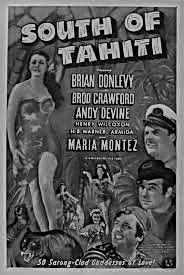 SOUTH OF TAHITI (1941)
SOUTH OF TAHITI (1941) (75 Min.) Genre: 1940 COMEDY, Transfer Quality: B
An entertaining amalgam of Universal contract players, leftover sets and stock footage, South of Tahiti stars Brian Donlevy, Broderick Crawford and Andy Devine as Bob, Chuck and Moose, three stooge-like sailors who land on a South Sea island. While Bob pitches woos at voluptuous native girl Melahi (Maria Montez in one of her earliest leading roles), Chuck and Moose try to plunder a valuable-and sacred--bed of pearls. Nothing much happens after this, except for a few dozen shots of gorgeous Universal starlets in various states of undress. H.B. Warner, who in his heyday played Jesus in DeMille's The King of Kings, brings a modicum of dignity to the proceedings as a native chieftan. Even at its weakest, South of Tahiti is slick and pleasantly amusing.
Starring: Brian Donlevy, Broderick Crawford, Andy Devine, Maria Montez | Directed by: George Waggner
 TALK OF THE TOWN, THE (1942)
TALK OF THE TOWN, THE (1942) (118 Min.) Genre: 1940 COMEDY, Transfer Quality: A
George Stevens' Talk of the Town is a quick-witted comedy driven by wonderful performances by Cary Grant, Ronald Colman and Jean Arthur. Michael Lightcap (Colman) is a stuffy law professor in line to a Supreme Court appointment, who is spending the summer at the house of schoolteacher Nora Shelley (Arthur). But Lightcap is not the only guest at the house. Shelley has also let Leopold Dilg (Grant)--a man who had recently escaped from prison, where he was serving a sentence for false accusations of immolating a local factory--stay at the house, telling Lightcap that he is a gardener. In addition to striking up a friendship, Lightcap and Dilg also compete for the affections of Shelley. Eventually, the professor learns of Dilg's true identity, finding out that Leopold was framed by a crooked government, led by the foreman of the factory, who supposedly died in the fire. When Dilg is captured by the police, Lightcap comes to his defense, bringing the still-alive foreman out of hiding and, in the process, clearing Leopold of all the charges. Talk of the Town received Academy Award nominations for Best Picture, Best Screenplay, Best Original Story, Best Score, Best Editing, and Best Interior Decoration, yet it lost in all of the categories.
Starring: Cary Grant, Jean Arthur, Ronald Colman, Edgar Buchanan, | Directed by: George Stevens
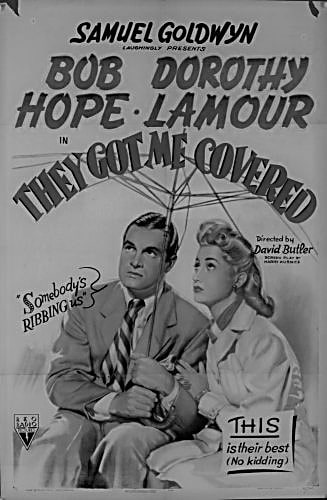 THEY GOT ME COVERED (1942)
THEY GOT ME COVERED (1942) (95 Min.) Genre: 1940 COMEDY, Transfer Quality: A
Bob Hope's first starring vehicle for producer Sam Goldwyn borrows the title of Bob's 1942 autobiography They Got Me Covered and very little else. Co-scripted by Leonard Q. Ross (aka Leo Rosten), Leonard Spigelgass and Harry Kurnitz (among many others!), the film casts Hope as Robert Kittredge, the Moscow correspondent for a major American news service, who is fired when he neglects to file a report about Hitler's invasion of Russia. Hoping to get back in the good graces of his boss Norman Mason (Donald MacBride), Kittredge steals another reporter's story about a Nazi spy ring operating in New York. Though officially a comedy, the film is curiously unfunny at times, with Hope playing an unsympathetic, unappealing character who'll step on anyone — including his long-suffering sweetheart (Dorothy Lamour) and a hysterical kidnap victim (Phyllis Povah) — to get ahead. Otto Preminger is funnier (perhaps intentionally) as the head Nazi. A few good gags notwithstanding, They Got Me Covered is nowhere near as satisfying as Hope's second Goldwyn effort, The Princess and the Pirate. — Hal Erickson
Starring: Bob Hope, Dorothy Lamour, Otto Preminger, Eduardo Ciannelli | Directed by: David Butler
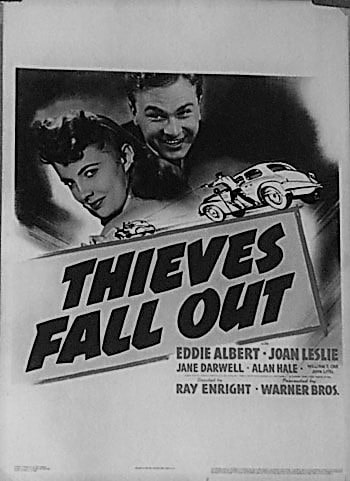 THIEVES FALL OUT (1941)
THIEVES FALL OUT (1941) (72 Min.) Genre: 1940 COMEDY, Transfer Quality: B
In this comedy, a grandmother decides to help her naive grandson get the money he needs to marry his girl by allowing him to get his inheritance, a mattress factory, before she dies. She suggests that he use it as collateral on a loan, but instead the young man sells the business to a crook who ends up charging another interested buyer an exorbitant interest rate for it. The angry buyer then tries to force the lad's father to buy back the factory. That doesn't work, so he ends up kidnapping the grandmother. This is not a wise move as the grandmother is far more clever than her captor and quickly turns the situation around to her advantage. Soon the kidnapper hands the factory back and gets nothing in return.
Starring: Eddie Albert, Joan Leslie, Jane Darwell, Alan Hale | Directed by: Ray Enright
 TO BE OR NOT TO BE (1942)
TO BE OR NOT TO BE (1942) (99 Min.) Genre: 1940 COMEDY, Transfer Quality: A
Ernst Lubitsch directs the 1942 political satire classic To Be or Not to Be, which marked the final screen appearance of comedienne Carole Lombard. In Warsaw at the beginning of WWII, Maria Tura (Lombard) and husband Joseph (Jack Benny) perform anti-Nazi plays with their theatre troupe until they are forced to switch to Shakespeare's Hamlet. Lt. Stanislav Sobinski (Robert Stack) falls for Maria and meets up with her during Joseph's famous "To Be or Not to Be" speech as Hamlet. When Stanislav is eventually dispatched for war, he implicates Maria with Professor Siletsky (Stanley Ridges), who has a secret plan to destroy the Warsaw resistance. The Polish theatre troupe is then forced to use their theatrical skills to ensure their survival. Eventually they turn to impersonating Nazi officers — and even Hitler himself — in order to outwit the enemy and keep the resistance safe from spies. To Be Or Not to Be opened to a controversial release in 1942, when the U.S. was still very much involved in WWII. It was remade in 1983 starring Mel Brooks and real-life wife Anne Bancroft. — Andrea LeVasseur
Starring: Jack Benny, Carole Lombard, Robert Stack, Felix Bressart | Directed by: Ernst Lubitsch
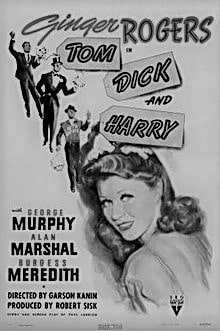 TOM, DICK AND HARRY (1941)
TOM, DICK AND HARRY (1941) (86 Min.) Genre: 1940 COMEDY, Transfer Quality: A
Working girl Ginger Rogers (who dresses like movie star Ginger Rogers, despite her meager salary!) cannot decide which of her three suitors will march her down the aisle. Will it be fast-talking automobile salesman George Murphy, wealthy Alan Marshall, or free-spirited, eternally unemployed Burgess Meredith? She mulls over her choices in a series of hilarious dream sequences (the best involving Meredith, along with three baby Merediths crawling on the floor). If her final decision takes you by surprise, you're in good company: according to one of the cast members, director Garson Kanin and Oscar-nominated screenwriter Paul Jarrico kept the denouement a secret until the last day of shooting. Featured in the cast is Phil Silvers as a delightfully obnoxious ice cream vendor, and, in a microscopic role, Jack Briggs, who would eventually marry Ms. Rogers. A favorite with both audiences and critics, Tom, Dick & Harry was ineffectively remade in 1957 as the Jane Powell musical The Girl Most Likely. — Hal Erickson
Starring: Ginger Rogers, George Murphy, Alan Marshal, Burgess Meredith | Directed by: Garson Kanin
 TOO MANY HUSBANDS (1940)
TOO MANY HUSBANDS (1940) (84 Min.) Genre: 1940 COMEDY, Transfer Quality: B
The W. Somerset Maugham play Home and Beauty was successful Americanized as Too Many Husbands (British title: My Two Husbands). Led to believe that her husband Fred MacMurray has drowned in a shipwreck, socialite Jean Arthur marries Melvyn Douglas. In time-honored Enoch Arden fashion, MacMurray turns up alive. The rest of the film finds Jean's two husbands figuratively duking it out for her affections. For a Production Code-era film, Too Many Husbands is remarkably risque, with a delicious open-ended denouement. And besides, we get to see the matchless Jean Arthur do the rhumba! In 1955, Columbia trotted out this property once more, and the result was the musical comedy Three For The Show, starring Jack Lemmon and Marge & Gower Champion.
Starring: Jean Arthur, Fred MacMurray, Melvyn Douglas, Harry Davenport | Directed by: Wesley Ruggles
 TWO SMART PEOPLE (1946)
TWO SMART PEOPLE (1946) (93 Min.) Genre: 1940 COMEDY, Transfer Quality: A
One of two con-artists ends up arrested and given five days of freedom before he must go to jail. This comedy chronicles those five days. The man loves to eat; knowing that prison food is lousy, he decides to spend his days stuffing himself with the finest foods available. He is accompanied to numerous 4-star restaurants by his partner and the arresting officer. Each of these two are interested in learning where he stashed a half-million dollars in loot. Eventually the man begins looking at his lovely partner and thinking of things other than his stomach. This leads to marriage. After serving his time, he and his bride go on to lead honest lives.
Starring: Lucille Ball, John Hodiak, Lloyd Nolan, Hugo Haas, Elisha Cook Jr. | Directed by: Jules Dassin
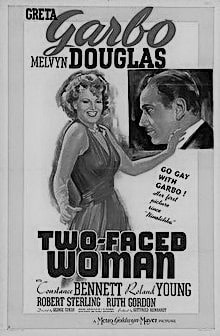 TWO-FACED WOMAN (1941)
TWO-FACED WOMAN (1941) (90 Min.) Genre: 1940 COMEDY, Transfer Quality: A
Attempting to Americanize Greta Garbo to appeal to American audiences (since most of the foreign markets for Hollywood product had been cut off due to World War II), M.G.M.'s Two-Faced Woman succeeded in making Garbo angry enough to announce her retirement from the screen. Two-Faced Woman was Garbo's final screen appearance, as the legendary actress slipped into a reclusive existence that lasted until her death. This George Cukor romantic comedy casts Garbo as ski instructor Karin Borg Blake. She gives lessons to wealthy American playboy Larry Blake (Melvyn Douglas), and the two fall in love and marry even though Larry has a girlfriend named Griselda Vaughn (Constance Bennett) waiting for him back in New York. Returning to New York, Karin fears that Griselda will win Larry back. In an effort to foil Larry's imagined dalliance, Karin poses as her own twin sister, Katherine, hoping to get Larry to fall in love with her instead of Griselda. Larry is onto the scheme and plays along with her, pretending to fall in love with Katherine. But this infuriates Karin, who can't believe that her husband would fall in love with her sister, and she storms back to her ski resort. — Paul Brenner
Starring: Greta Garbo, Melvyn Douglas, Constance Bennett, Ruth Gordon | Directed by: George Cukor
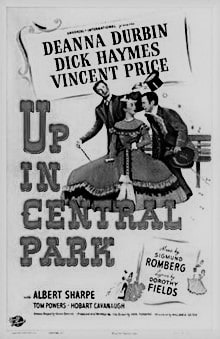 UP IN CENTRAL PARK (1948)
UP IN CENTRAL PARK (1948) (88 Min.) Genre: 1940 COMEDY, Transfer Quality: B
The Dorothy Fields-Sigmund Romberg Broadway musical Up in Central Park has been retooled as a vehicle for a pleasantly plump Deanna Durbin. Set in New York in the 1870s, the film casts Durbin as hoydenish Irish immigrant Rosie Moore, who becomes the romantic bone of contention between muckraking newspaper reporter John Matthews (Dick Haymes) and corrupt but charming political boss Tweed (Vincent Price, considerably handsomer and slimmer than the real Tweed). With Rosie's help, John manages to expose Tweed's Tammany Hall shenanigans. Though only two songs have been retained from the original Broadway production, both Durbin and Haymes are afforded several opportunities to sing. Featured in the cast as Durbin's father is Albert Sharpe, who'd just completed a run in the smash New York musical Finian's Rainbow and who later played the title role in Disney's Darby O'Gill and the Little People (1959). Best scene: The Currier & Ives ballet, one of the few holdovers from the stage version of Up in Central Park.
Starring: Deanna Durbin, Dick Haymes, Vincent Price, Albert Sharpe | Directed by: William Seiter
 YOU'LL FIND OUT (1940)
YOU'LL FIND OUT (1940) (97 Min.) Genre: 1940 COMEDY, Transfer Quality: A
Considering that it contains the one and only cinematic group appearance by Boris Karloff, Peter Lorre and Bela Lugosi, You'll Find Out must rank as one of the most lamentable missed opportunities in movie history. Essentially a vehicle for bandleader Kay Kyser and his orchestra, the film finds Kyser hired to perform at the 21st birthday party of heiress Janis Bellacrest (Helen Parrish), the sweetheart of Kay's business manager Chuck Deems (Dennis O'Keefe). The party is held at Janis' family mansion, a spooky old joint dominated by astrology-happy Aunt Margo (Alma Kruger). Among the guests stranded in the mansion by inclement weather are mysterious mystic Prince Sallano (Bela Lugosi), family attorney Judge Mainwaring (Boris Karloff) and Professor Henninger (Peter Lorre). Though advertised as a "mystery", the film throws the whodunit angle out the window at midway point by revealing that Sallano, Mainwaring and Henninger are in cahoots, planning to kill Janis to get their hands on her inheritance. These sinister goings-on do not impede Kyser's ability to stage several musical numbers, including "The Bad Humor Man", which, according to studio publicity, was supposed to have been performed by Karloff, Lorre and Lugosi! Once the plot is resolved, Kyser utilizes several of Sallano's props-including the then-new "Sonovox" machine and an electronic zapping device-on his radio program, leading to a wickedly satisfying closing gag. Everyone tries hard to get laughs (none harder than mop-topped Kyser musician Ish Kabibble), but You'll Find Out is for the most part singularly unamusing; still, one shouldn't pass up the opportunity to see Hollywood's "three titans of terror" on the same screen. — Hal Erickson
Starring: Peter Lorre, Boris Karloff, Bela Lugosi, Helen Parrish, Dennis O'Keefe | Directed by: David Butler

